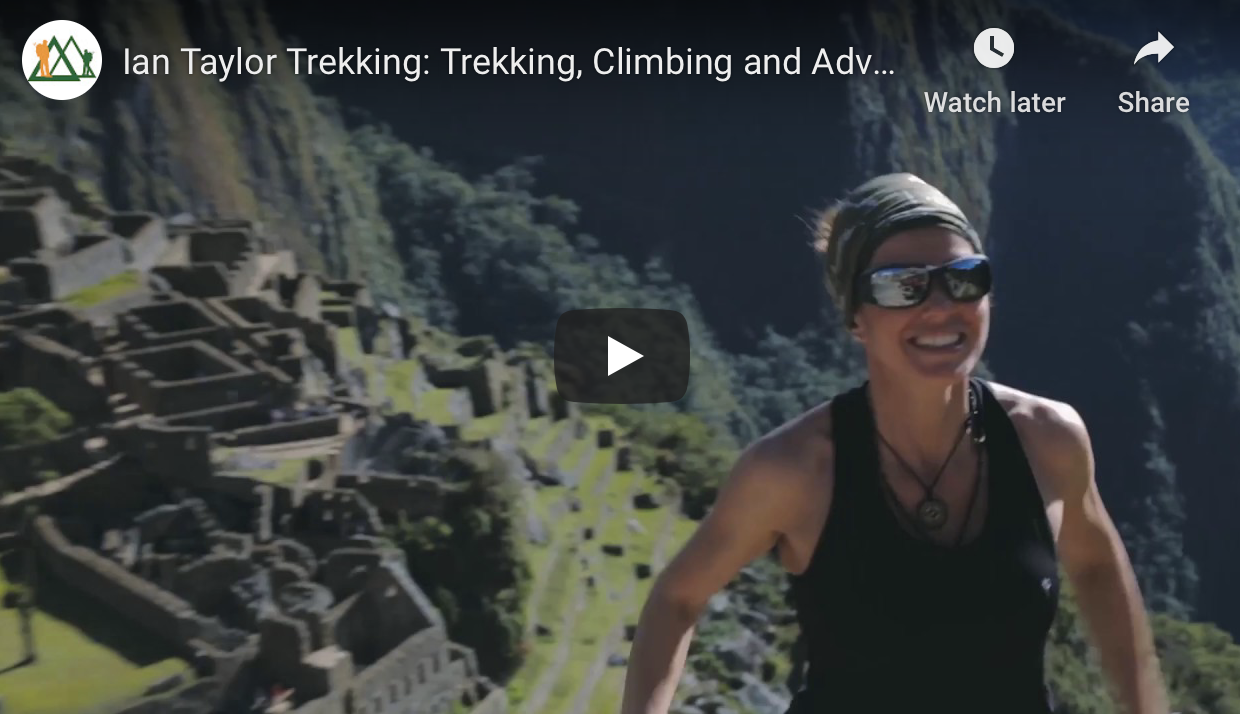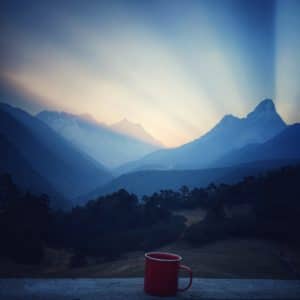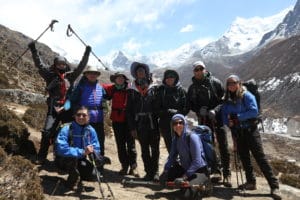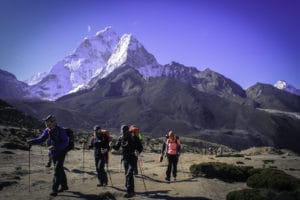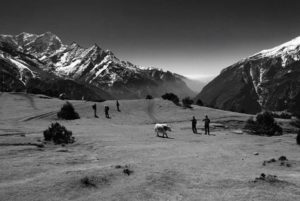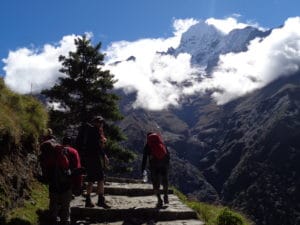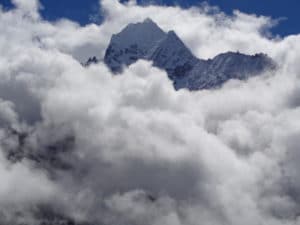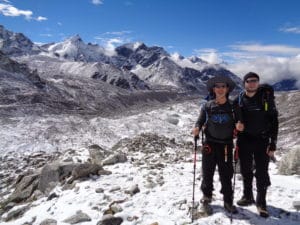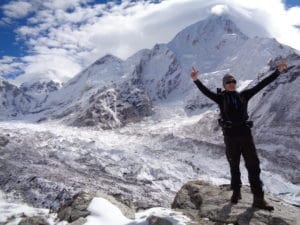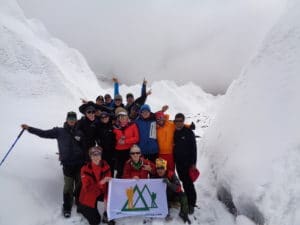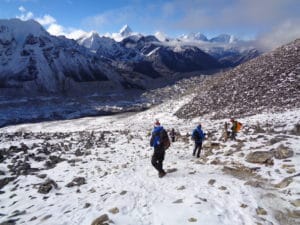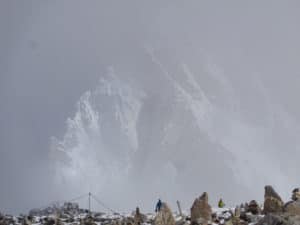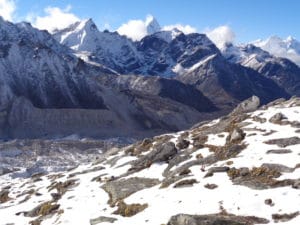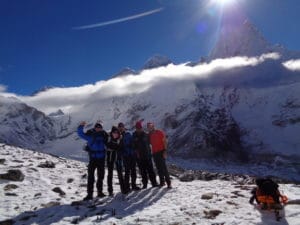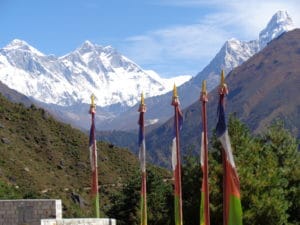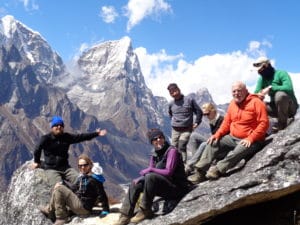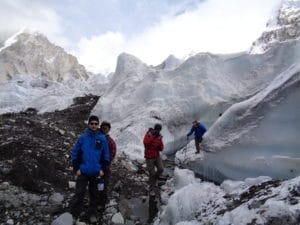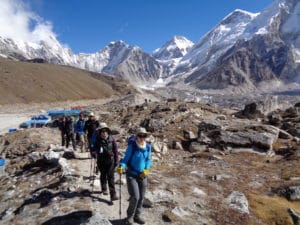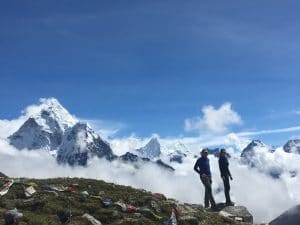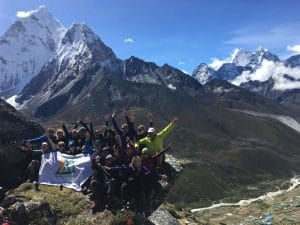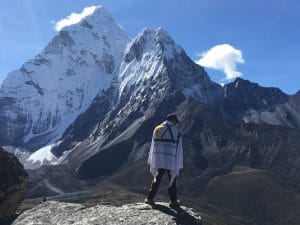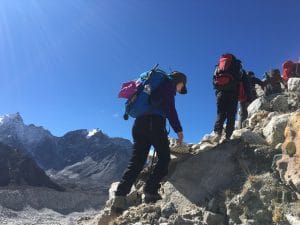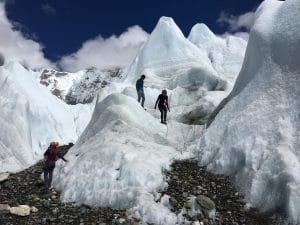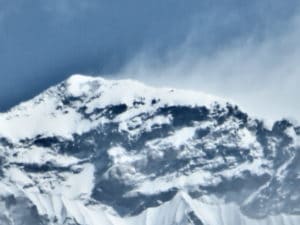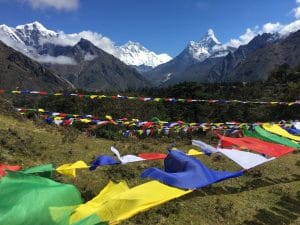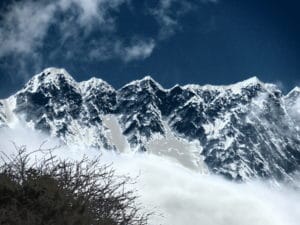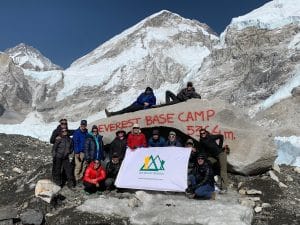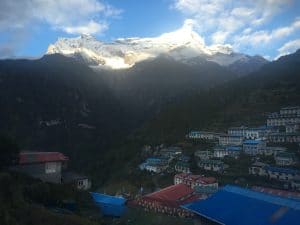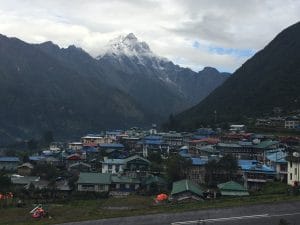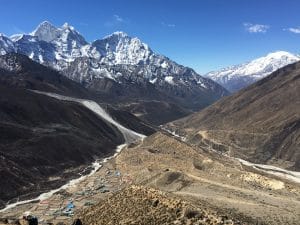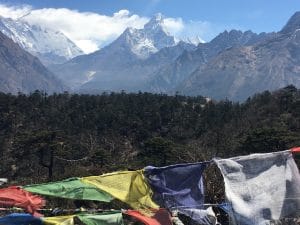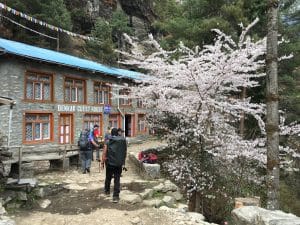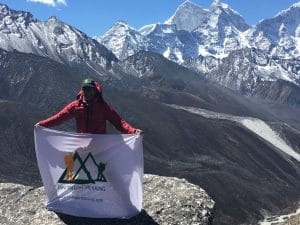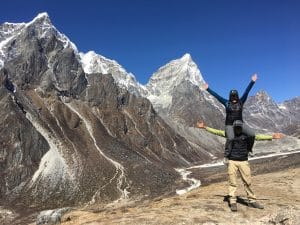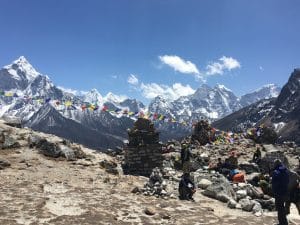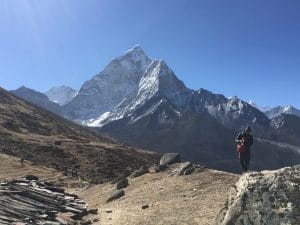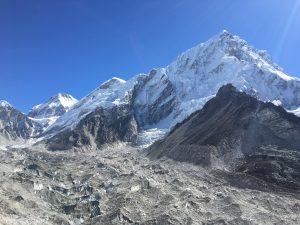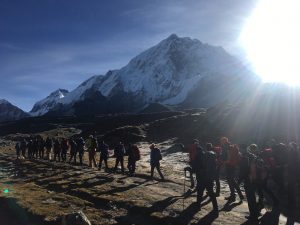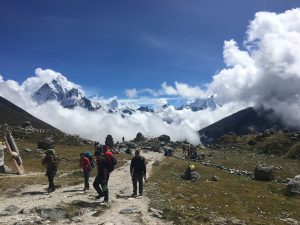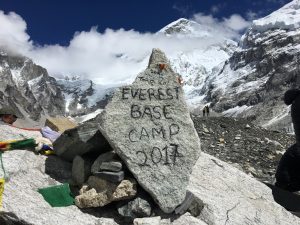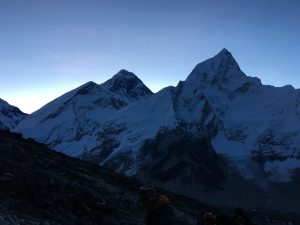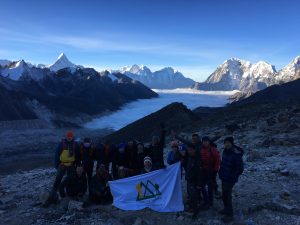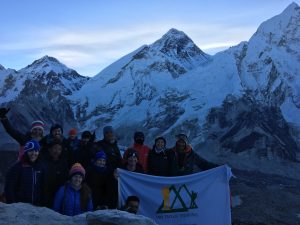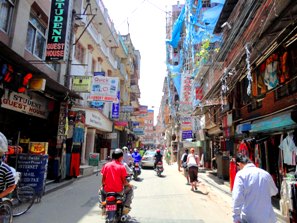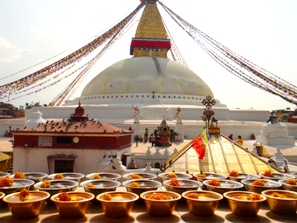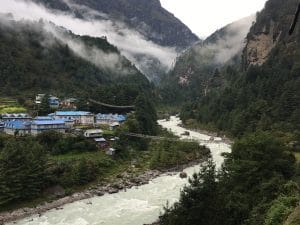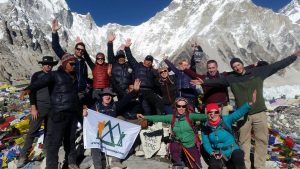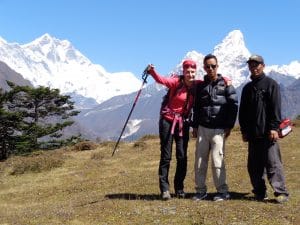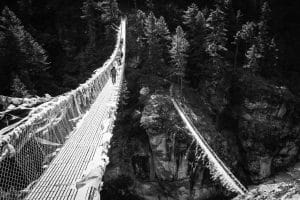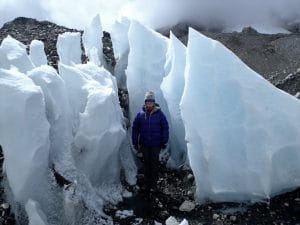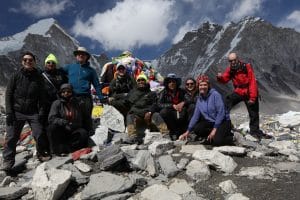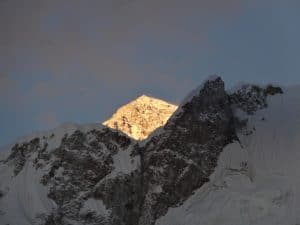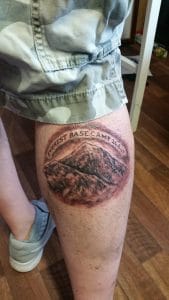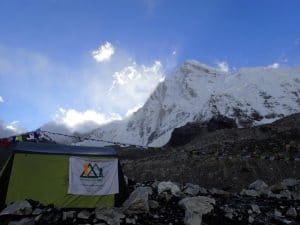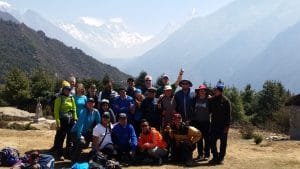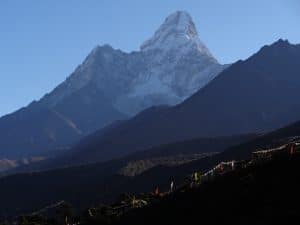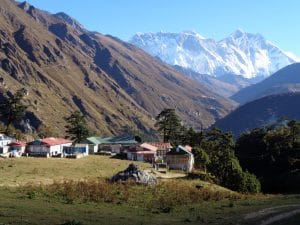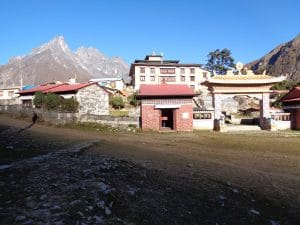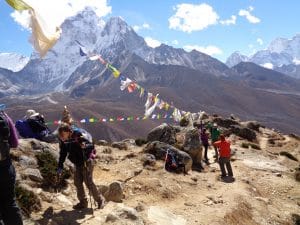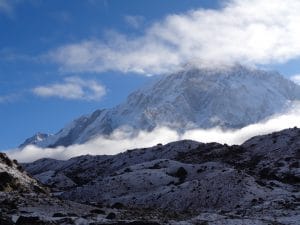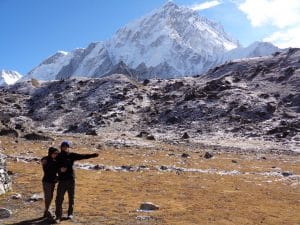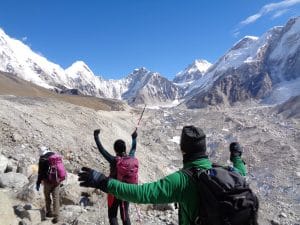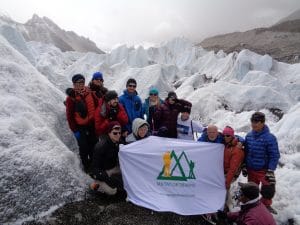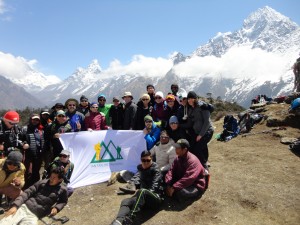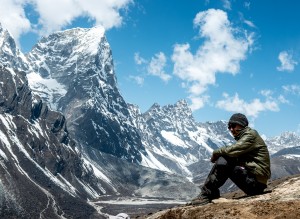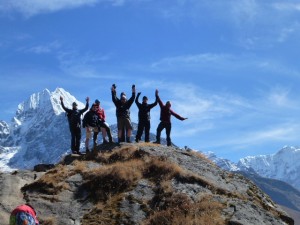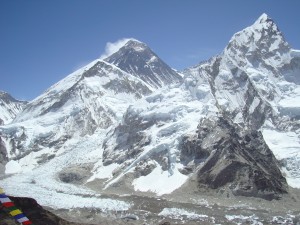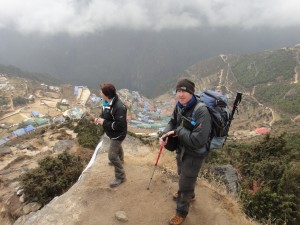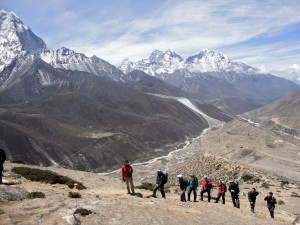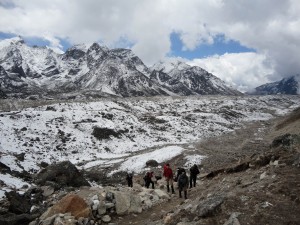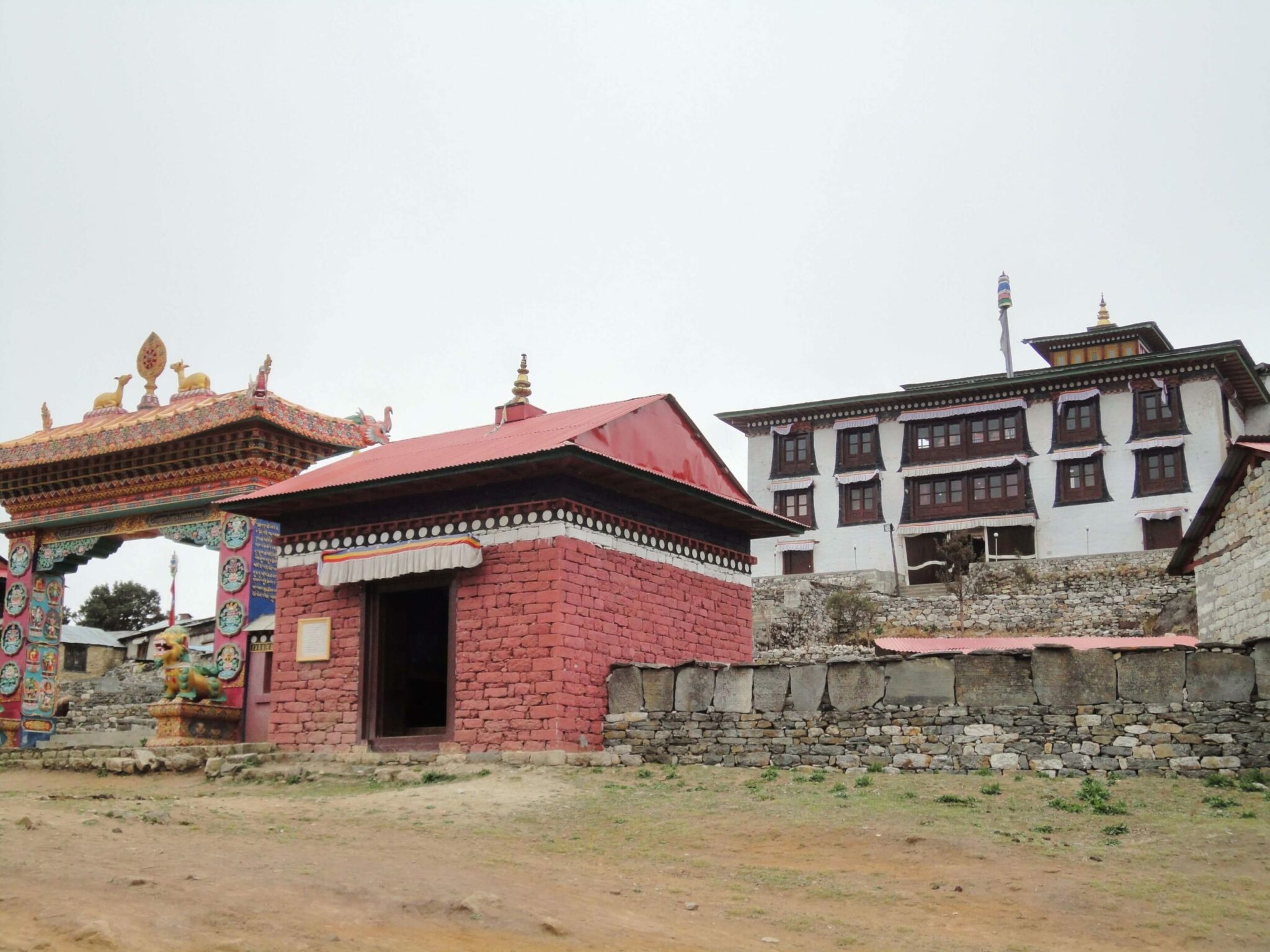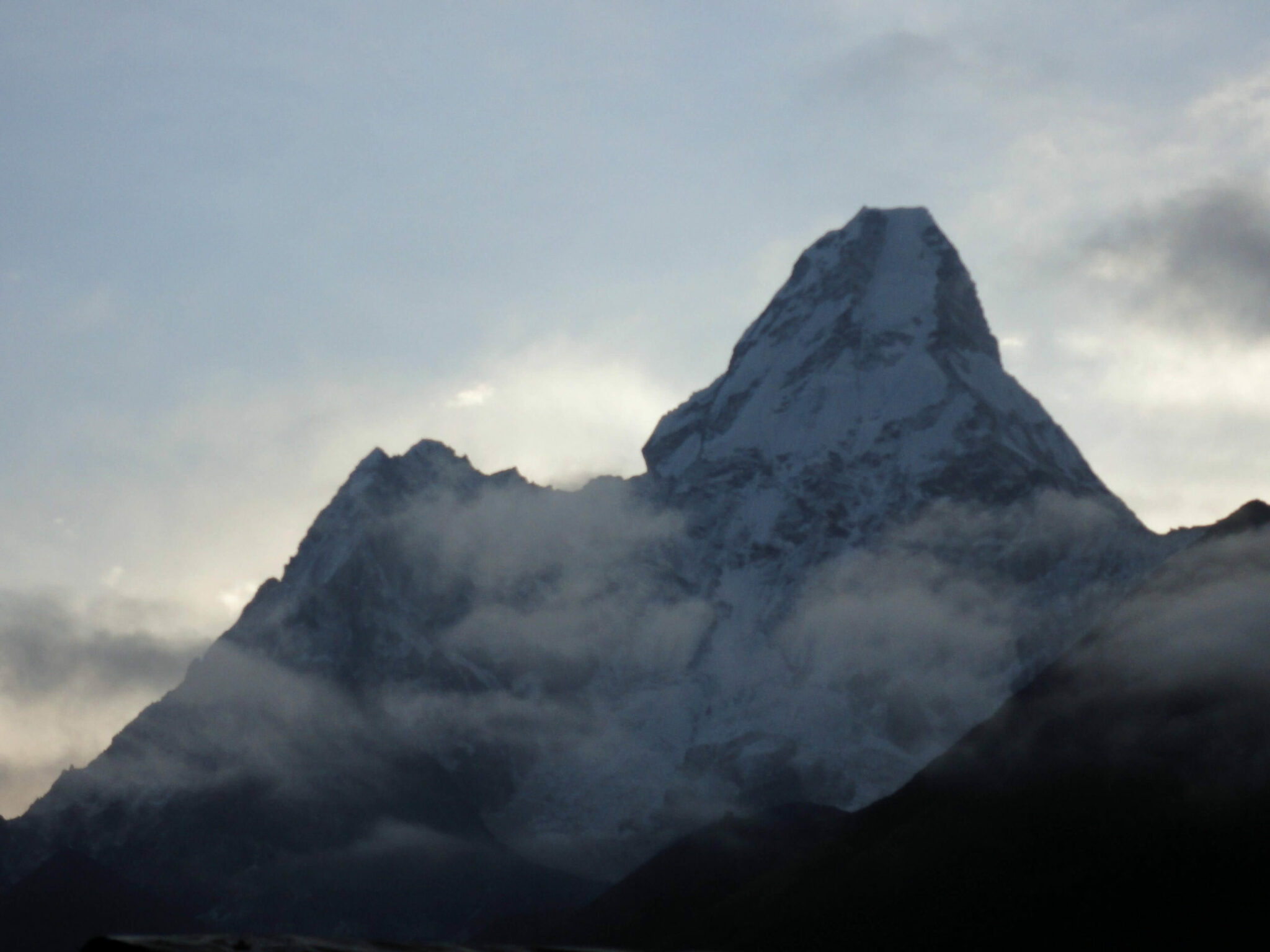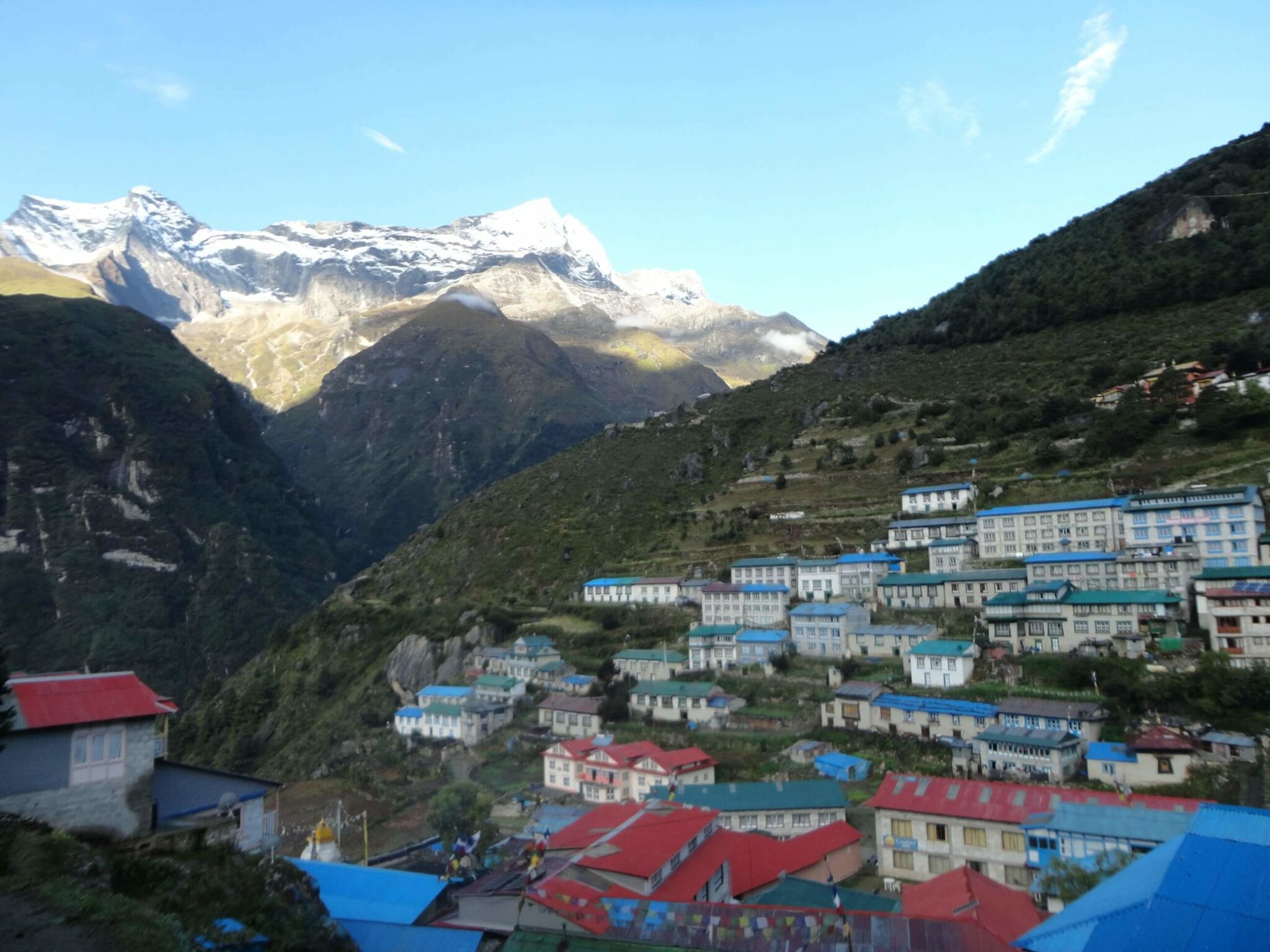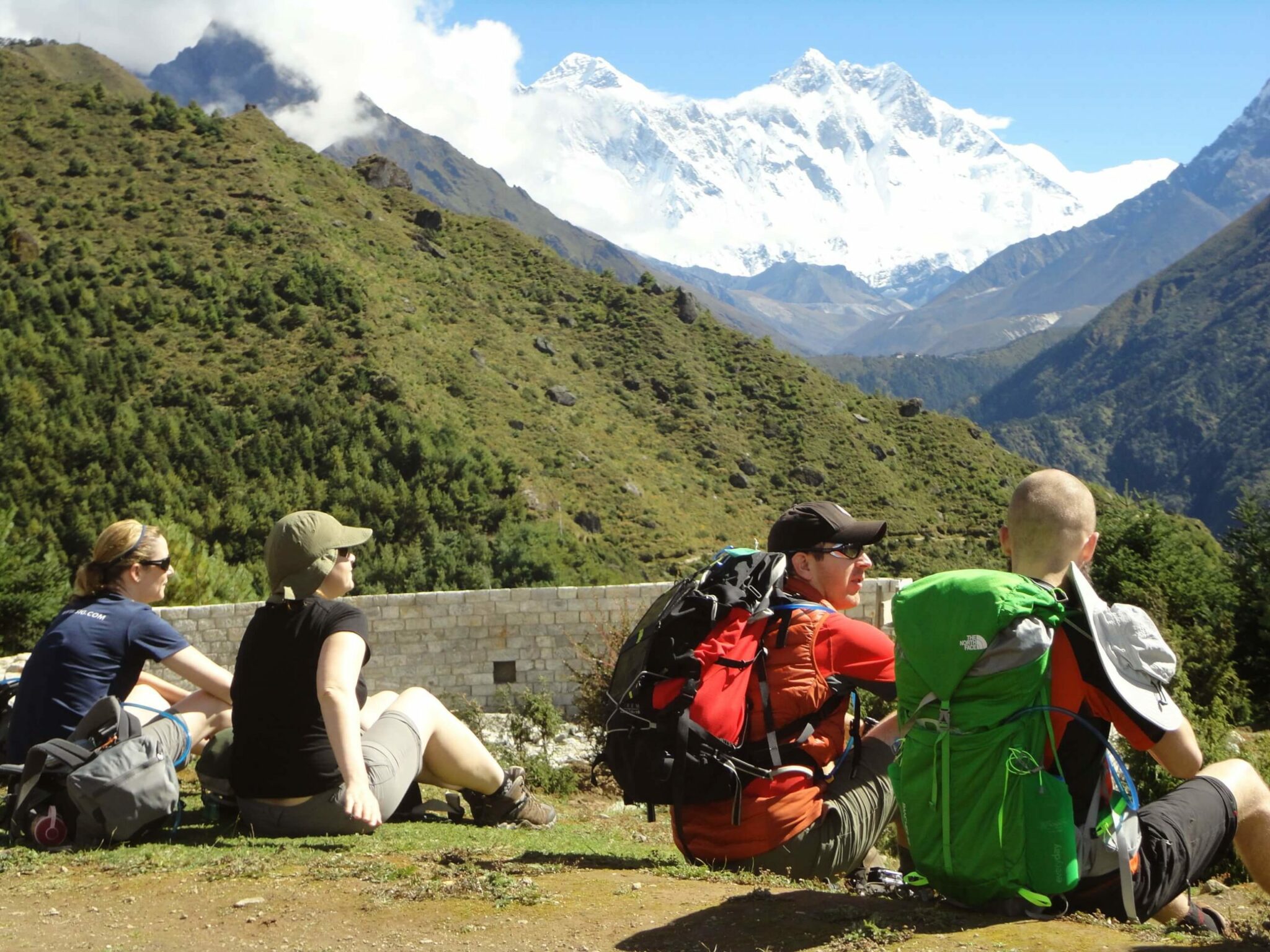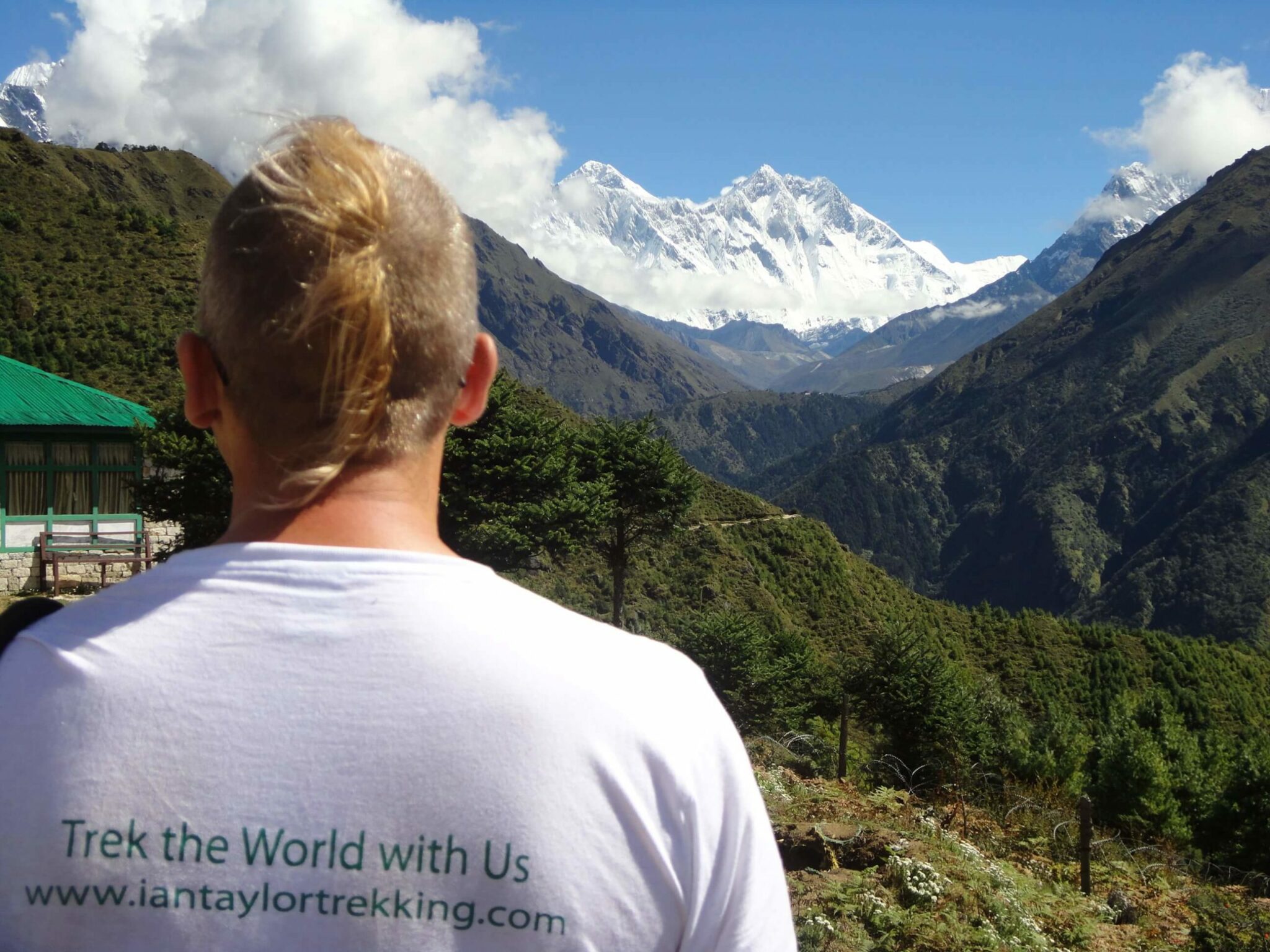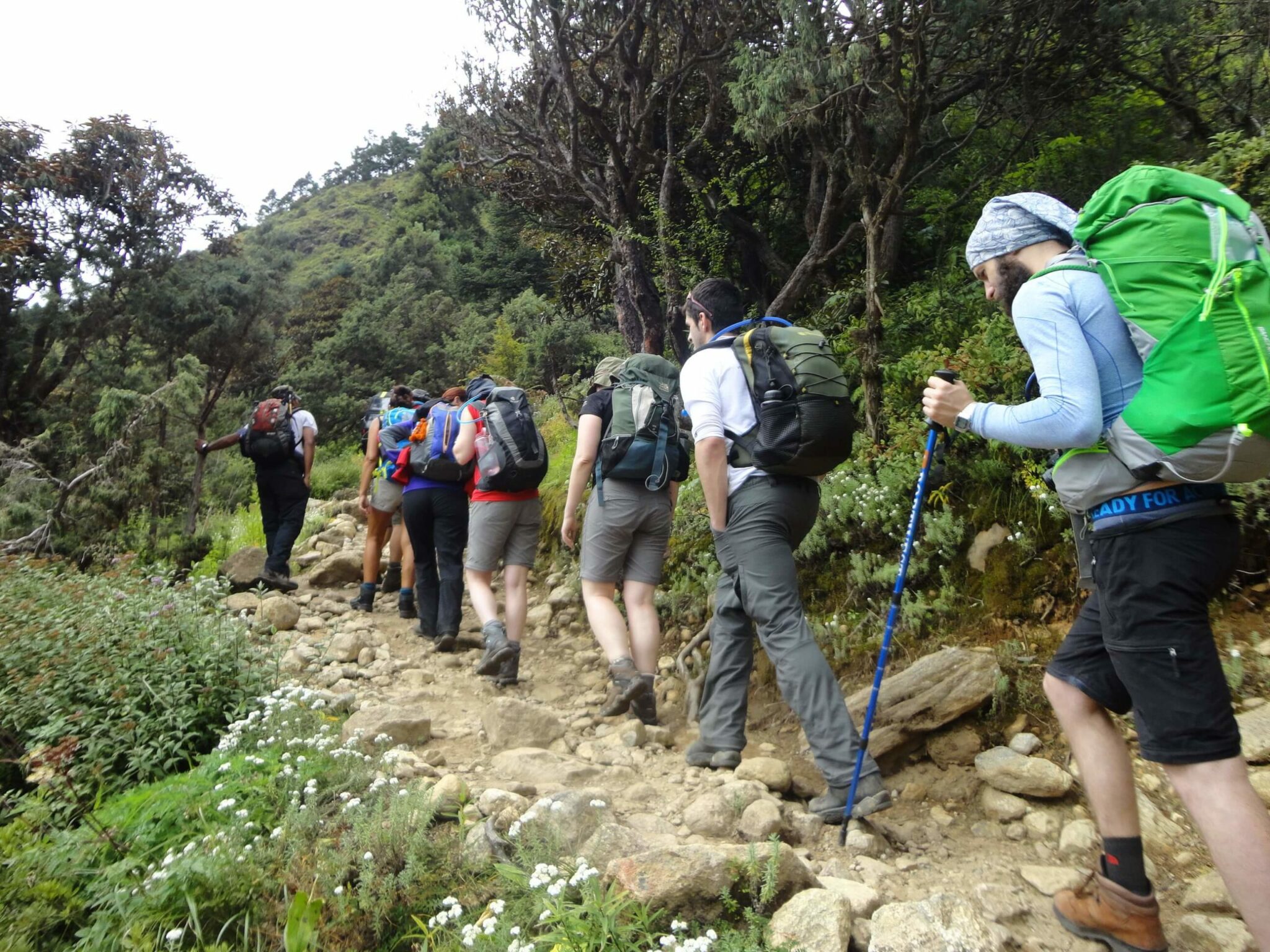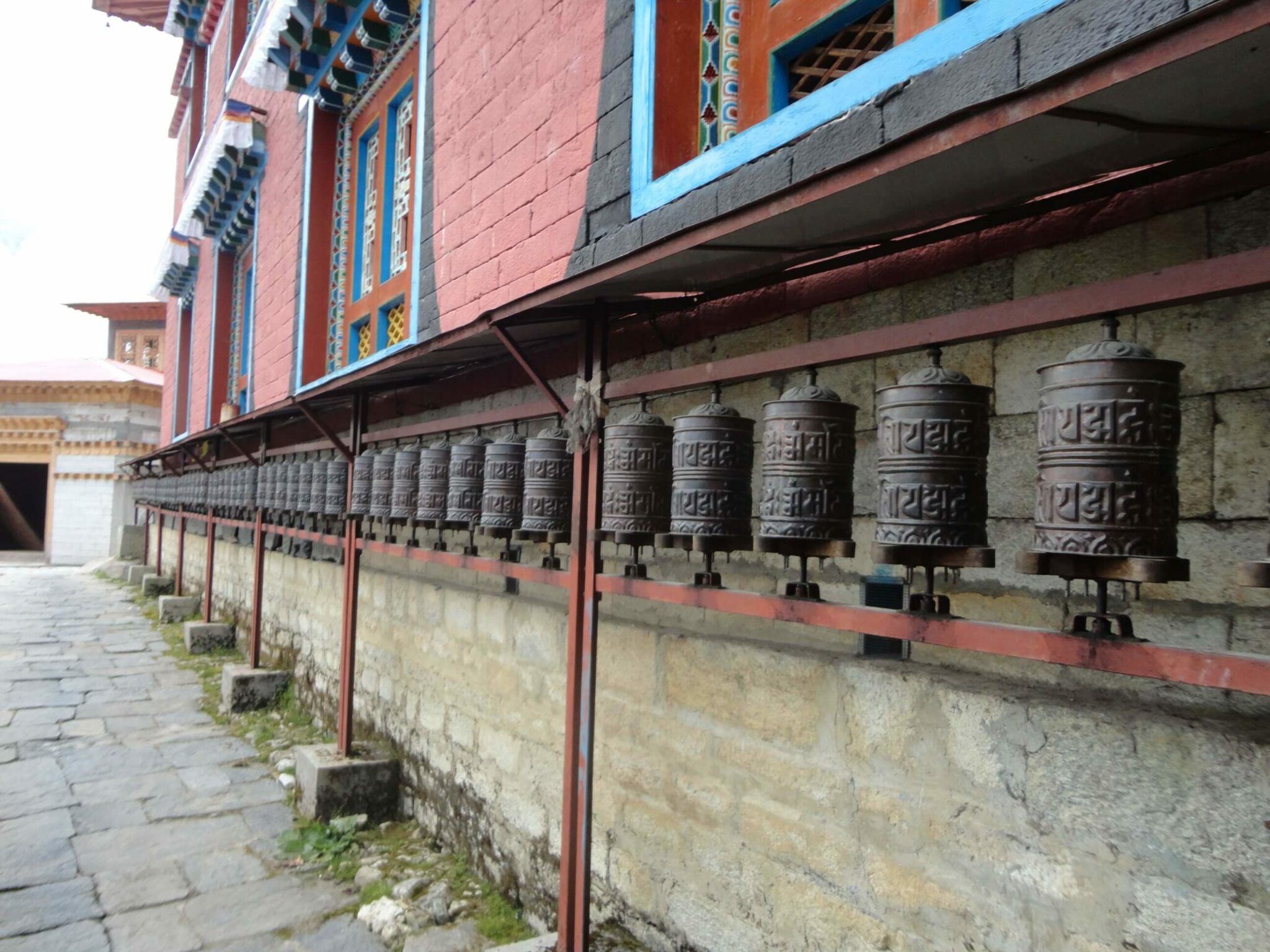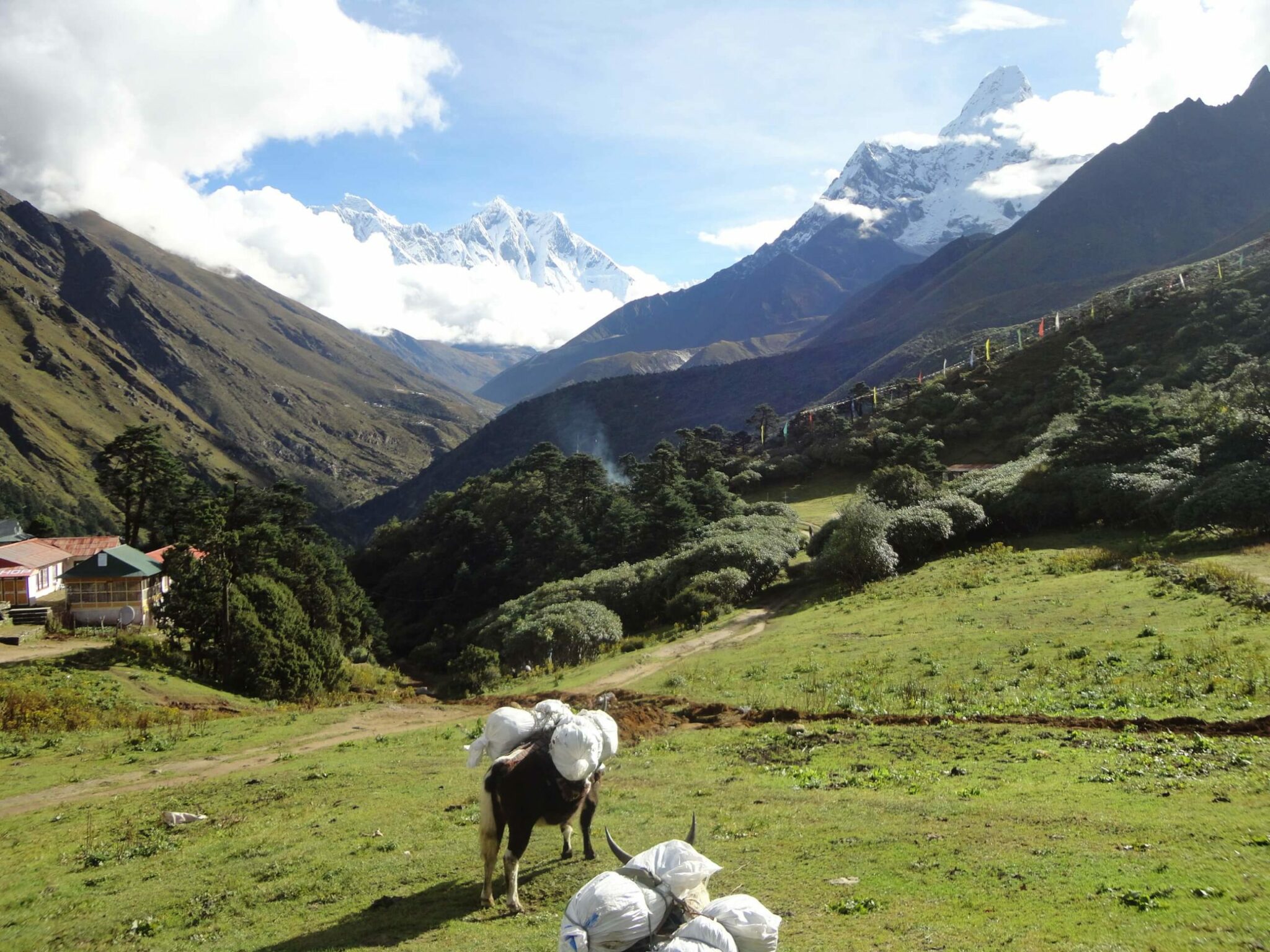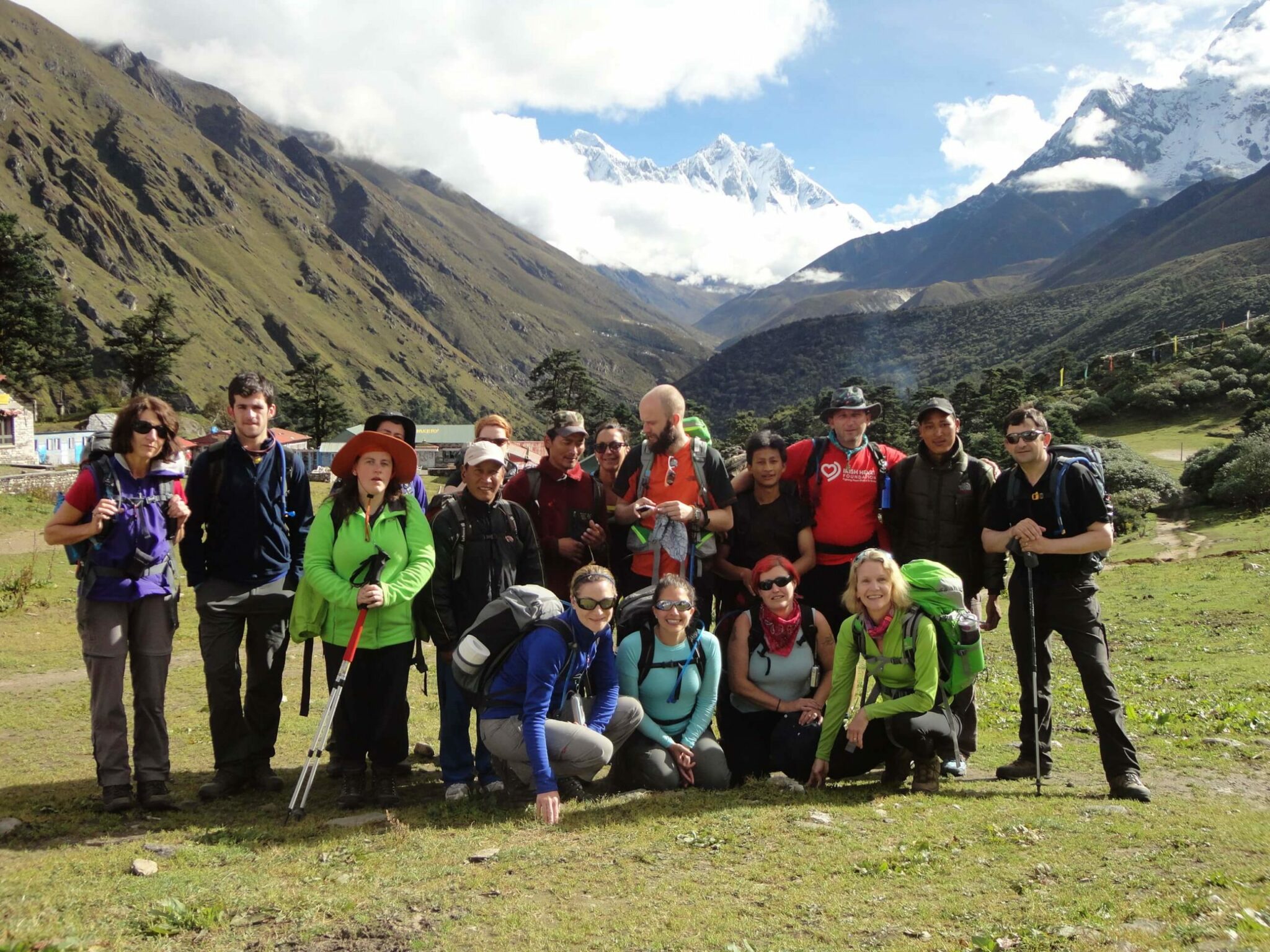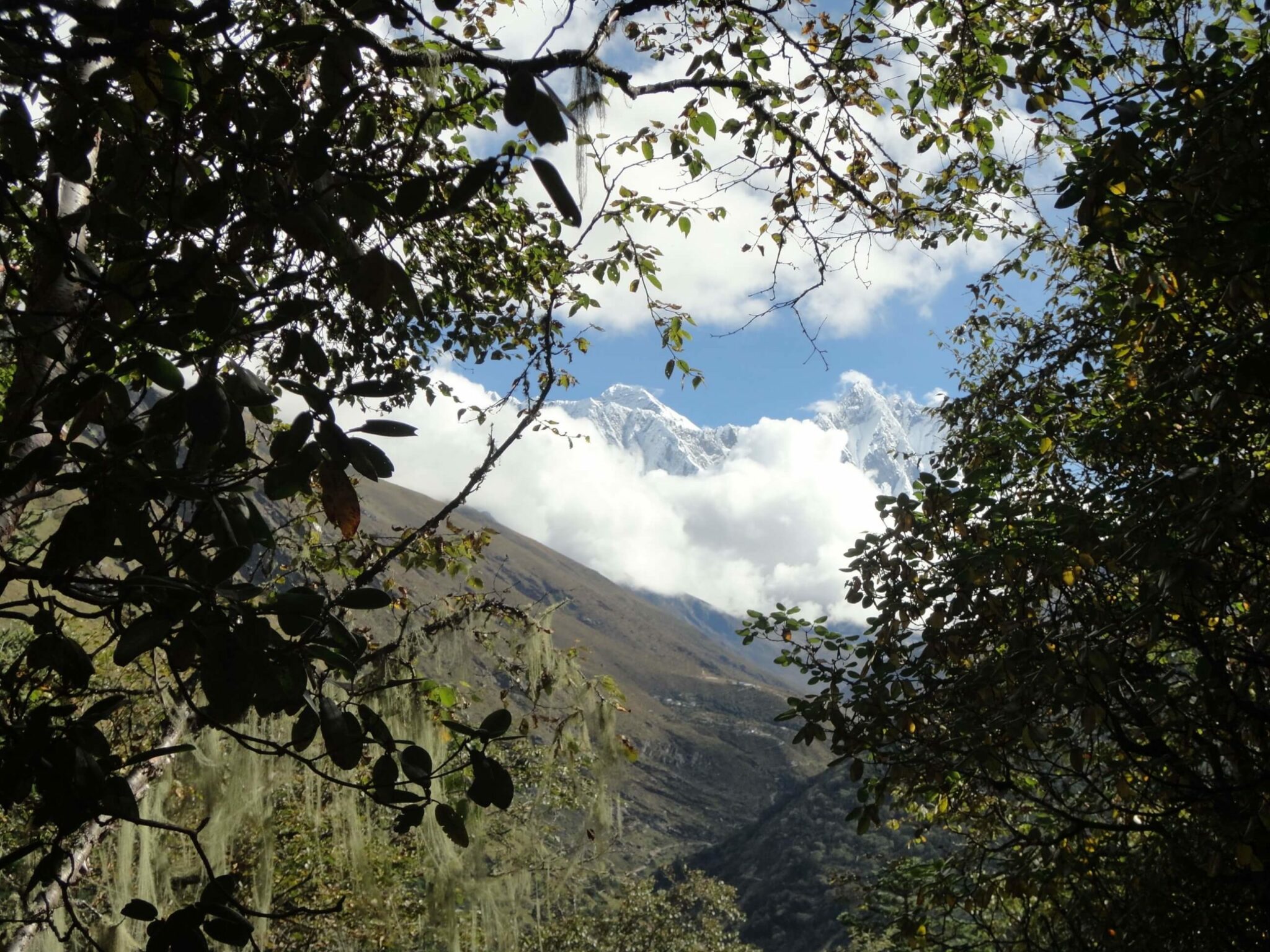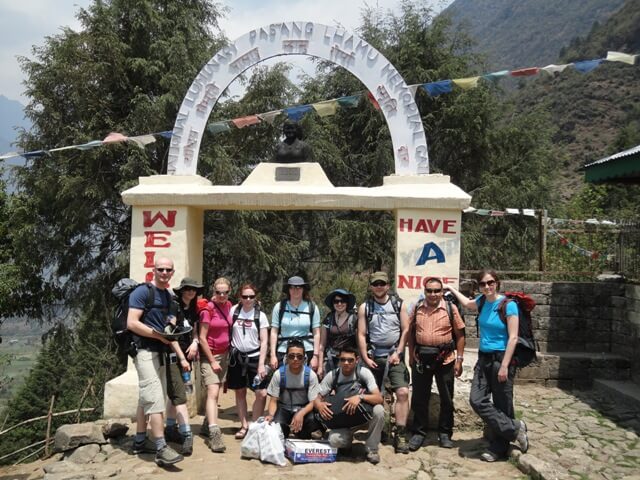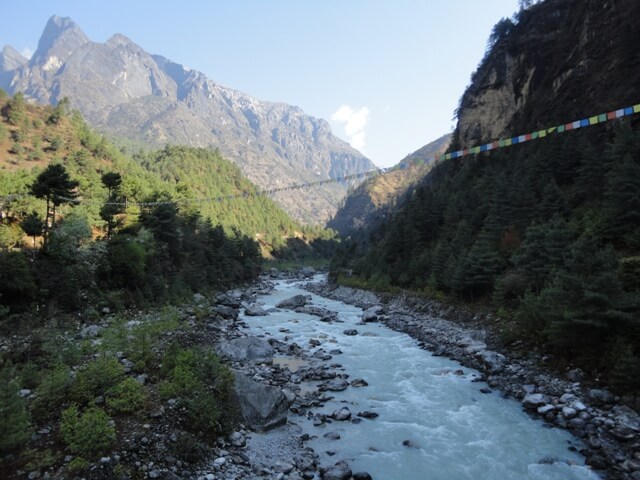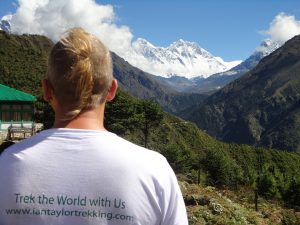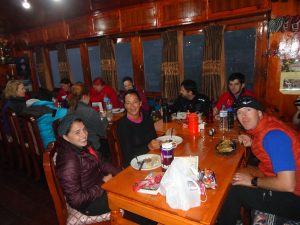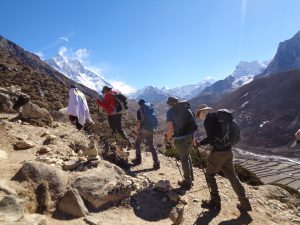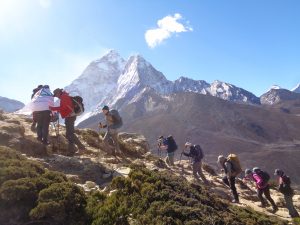Tengbouche Monastery Trek
Our Tengbouche monastery trek is by no means an easy task. With our expertise and experience, we will provide you with all the necessary information you need to make your trip a success. We will make sure that you are prepared both physically and mentally as well as to make sure that you have trained with and bring the necessary gear and equipment that will make your trip on the Tengbouche monastery trek is a pleasurable and successful adventure. This trips costs $2,400.
Tips & Advice
We have led thousands of people to Everest Base Camp over the years! These twenty reasons will show you why you should choose Ian Taylor Trekking to make this journey to the base of the highest mountain in the world. We are selling out on some of our Everest Base Camp Treks 12 months in advance because we have our own full time staff, more acclimatization and success rates second to none. We use the better lodges and are available to our clients to give them all the information they need before the trek. Read some REVIEWS HERE.
1). Our Team
We have four guides for every group of ten trekkers on the trail! This is not the norm in the region and we do this because we want to make sure all of our teams have the best chance at safely reaching their goal. With more staff on the trail with your team, they will be able to more efficiently manage your safety on the trail and also give you a better experience along the way.
We do not outsource any of our treks and we have our own office in Kathmandu and our own staff who manage all of our trips. Therefore, this gives us far more consistency in our service on the ground. We have world class climbing Sherpa’s working with us and therefore, this helps us offer you quality treks, climbs and expeditions on every trip. Why not join one of our sleeping at Everest Base Camp Treks.
2). Supporting the Community
We continue to support the local community and have helped to establish the Goli Village Trust in Nepal. This was put into place after the earthquake in 2015, when the Village where many of our staff have come from was devastated. We have built two schools in the Goli region and we have placed stoves in over 60 homes. We do need donations and help, therefore if you would like to donate, set up a trek to the village, give funds, clothes or school items, then get in touch. Please let us know and we can help you figure out how you can best help!
3). Quality Trips
We run only run quality treks with more staff, better lodges and better food. Read some REVIEWS from our trips. You can also watch our Food and Accommodation video for further information. A lot of times people are only given the same food each day for every meal, and we don’t do this. You are allowed to pick what you eat for each meal to make sure that your dietary needs are met.
We pay our staff correctly and do not over load them with weight. Also, we use Yaks to carry all the loads where possible and we do not cut corners on any aspects of our treks or climbs. There will be a maximum of 10 people per group on our trips and we have 4 guides and support staff for 10 people.
4). Expert Training Advice
We offer personal service with training advice for our clients, 5 days a week. A lot of people underestimate the trek to Everest, and rely on helicopters to get them out of the region when they become too tired to continue. We do not want to see this happen with our clients. Therefore, we want to make sure that you have the best information on how to complete the trek safely and successfully.
There are some long 8+ hour days, covering over 20km with over 700m/ 2,296 feet of up and down hill on steps or stairs while on the trail. We have professional training advice available to you 5 days a week. All you have to do is e-mail us at info@iantaylortrekking.com, and we can schedule calls with you as often as needed once you sign up to our trips.
5). Sleeping in Everest Base Camp
We are the first trekking company to be able to offer an option for you to Sleep one night in Everest Base Camp! This is a very unique and special opportunity for trekkers as it has only been reserved for expedition team members in the past. However, we do want to limit our footprint in Base Camp, so we do only offer a limited number of these trips a year. Having the opportunity to wake up at the base of the worlds highest mountain is one not to be missed!
6). Trek with an Everest Summiteer
Why not sign up to one of the trips that Ian personally leads? You can walk through the region with someone who not only has gone to Base Camp over 35 times, but also has reached the top of Mount Everest! Ian usually leads two Everest Base Camp treks a year, combined with an Island Peak ascent which he has completed over 17+ climbs, and if you book far enough in advance, you could join him! Sign up and get access today. READ MORE.
7). 25 Years Experience
We have years of experience managing teams on the ground in Nepal. Our head guide has been at the forefront of tourism in Nepal for over 25 years. He is well connected on the ground with access to all the key organization and authorities. He is also passionate about the Sherpa culture, experience and preserving these traditions.
Anyone who has trekked with Dawa Chirri Sherpa will never forget it! Even if you just get to spend time in Kathmandu with him, you will love and cherish the experience. Dawa is married to Kay from Scotland, and they run our office together in Kathmandu. All of our clients joining trips to Everest Base Camp will experience the hospitality and quality service we have to offer.
8). Fully Trained Staff
All of our guides hold current Wilderness First Aid Certificates. They are able to get you the help you need in case of an emergency. Also, our guides will carry satellite and local phones with them. We bring oxygen on all our treks and climbs and the tea houses we use also house supplies of oxygen for emergencies. We lead climbs on Island peak, Mera Peak, Lobuche, Tent Peak, North Col, Cho Oyu and so many more. You need to have access to oxygen and team who have additional support staff members available to assist you while you are on the trek to Mount Everest. Read some REVIEWS from our treks to Everest.
9). Quality Gear
On our Sleeping in Base Camp trips, we use quality, North Face Tents on all our trekking and mountaineering itineraries in Nepal. We do have the option for a single tent for your night sleeping in Base Camp, however all accommodation are on a shared basis. Our Everest Treks are in the better lodges, however, if you are in a private group, you can chose to camp all the way if you prefer.
10). 4 Star Hotel in Kathmandu
We include two nights in a hotel in four star hotel in Kathmandu. One night before your trek and one night after. All of our trips are on a shared basis, but if you prefer a single room, this can be offered at an additional cost. We use the Yatri Suites and Spa in Thamel, which is the main tourist district of the city. You can also upgrade to 5 star hotel option if you like, just ask us for further information.
11). Better Lodges
There is a wide range of accommodations in the Everest Region. Some of these are of a very poor quality/standard and we stay away from those! We use the better accommodations when available. All of the tea houses we use come with a pillow and comforter on your bed. You still need to have your own sleeping bag with you, but these better tea houses will provide a cleaner and more comfortable option along the way. We use Hotel Namche for the four nights we spend in Namche Bazaar. Three nights on the way up and one night on the way down the trail. Sleeping is a very important part of the acclimatization process and therefore getting to bed early and getting as much rest as possible is very important.
12). We Run over 30 Treks to Everest Base Camp per Year
We have the experience and expertise to run over 30 treks a year to Base Camp. Ian Taylor Trekking are a well known and respected company in the region. Because of this, we get preferential treatment with everything from flights in/out of Kathmandu, to helicopters and room availability in the tea houses. Many companies without this experience bring you into the region and don’t even have tea houses booked beforehand. This could ultimately leave you stuck without a place to stay during busy times. We would never put our clients in this predicament… we are always booked beforehand to offer you a no-stress experience!
13). Three Meals a Day
Food in the Everest Region has become increasingly more and more expensive. All of our trips include three, two course meals each day on the trail. Therefore, you do not have to worry about bringing extra funds for your food. READ MORE information about our food service on the trek. We can guarantee quality food throughout the trek because we use the better lodges available and they provide a higher standard of meals. Making sure you get enough food on the trail is very important. Therefore, we provide all your meals as part of your trip.
14). More Acclimatization
We have learned after years of experience that people need more time to acclimatize to the lower levels of oxygen, in order to have a safe and successful trip. Therefore, we now include three nights in Namche Bazaar at 3,500m/ 11,500 feet. This will help to give your body the time it needs to acclimatize correctly. Most companies are not doing this and we have seen over the years that it is a main factor in why more people on our trips are making it to Base Camp! We also include two nights in Dingbouche at 4,350m/ 14,271 feet, giving you the best chance of success!
15). Animals not Porters
We use animals instead of people to carry your duffel bag on the way to and from Everest Base Camp. The Yaks will carry up to 15kg/33 pounds of your personal gear on the trail. We will send you our 45 page dossier covering all aspects of the trip. This will also include an itemized kit list for you to review. We are available to speak with you on the phone or Skype get the right gear for your trek. Watch our PACKING VIDEO and do let us know if you have any questions.
16). Celebration Meal
We like to treat all of our teams to a celebratory meal at the end of your trek in Kathmandu! Ian’s favorite restaurant to enjoy after he is in the mountains is Fire and Ice Pizza Restaurant. Most of our teams will have the meal there as you can enjoy some delicious pizza after the trek (maybe even have a delicious mojito). This meal is included in the trip. You will be presented with your Everest Base Camp certificate of achievement and we will enjoy a beautiful meal before heading back to the hotel or a night out on the town.
17). Different Itinerary Options
We have multiple options for itineraries to Everest Base Camp. You can join our regular trek itinerary, Sleeping in Base Camp itinerary, Gokyo Lakes Itinerary or the Three Passes Trek! We can also tailor your trip to suit your needs for a private group. Therefore, if you have 4 or more people joining a trip, we can cater your private itinerary at no extra cost!
18). The Best Sherpa Team
If you want learn about the Sherpa people, then you have to hang out with Sherpa people. Our team of Sherpa guides and assistant guides are happy and proud to talk to you about the Sherpa people, culture and way of life! We have been working with our teams in Nepal for over 10 years now. They are some of the most wonderful and knowledgeable people you will meet in the region. Most of our teams also take the time in Namche Bazaar to visit Kanchha Sherpa, the only remaining Sherpa from the first Everest expedition. Giving you a chance to hear from him and ask questions of what it was like then!
19). Small Group Sizes
We only work with small group sizes. The maximum number of people per team will be 10 people. Some of our groups are even less people with only 6 or 8 team members. This will therefore give you are more personalized experience on the trail to Everest Base Camp. You can move as a team and experience more of this world class trail.
20). Private Groups with Free Space
We have an amazing opportunity for private groups of 10 or more hikers to get one free space! Therefore, if you are a part of a hiking group, walking club, group of friends or family that all want to go to Base Camp, gather 10 other paying clients to go and we will give one space for free! You can read more about this offer HERE.
Are you thinking to trekking to Everest Base Camp in Nepal? Here are all our important links and pages you need to read before trekking to Everest Base Camp. We have compiled this list of information for you to explore so that you can correctly prepare for your journey into the Everest region.
Ian has climbed Everest to the summit and led over 35 treks to Everest Base Camp. We have the tools you need to best prepare for this trip of a lifetime. If you are thinking of joining a trek to the worlds highest peak, then make sure you do your research, and choose the right team! We run over 30 trips a year to Everest Base Camp and are happy to get on a call to further discuss this amazing journey with you. Check out our upcoming trips and GET IN TOUCH today.
Important Pages
1). Pick the best acclimatization itinerary for your Everest Base Camp Trek
2). Get training, and learn the best way to prepare for your Trek to Everest
3). What heart rate zones should you be training in.
4). Here are our TOP 50 TIPS for trekking to Everest Base Camp
5). 20 reasons to pick Ian Taylor Trekking for your Everest Trek
6). Get FREE constant advice from our professional team
7). Understand the daily distance on the way up and down to Everest
8). Have the right clothing and gear for your Everest Base Camp Trek
9). Pacing each day on the trail is critical to success
10). Why hydration is critical at high altitude and in low oxygen environments
11). Elevation gains on the Everest trail. This will help you formulate a training plan
12). What sort of food will I get on the Everest Base Camp Trek.
13). Read our Top 10 Tips for a successful Everest trek.
14). Read our Top 11 Tips for when you are on the Everest Base Camp Trek.
15). Read about the best time to trek to Everest Base Camp.
16). What vaccinations should you consider for your Everest Base Camp Trek.
17). What type of trekking boots should you have for the Everest Base Camp Trek.
18). What Insurance do I need for my Everest Base Camp Trek.
19). What additional expenses will you incur on the Everest Trek.
20). What are the differences between trekking to Everest and climbing Kilimanjaro.
21). What are the best months for trekking to Everest Base Camp.
22). How do you train for hiking down hill.
Pick the Right Everest Base Camp Itinerary
The first think you need to do is pick the right itinerary, hence, there is no one size fits all. One key factor to consider is that you need to have as much acclimatization possible in the critical points of the trek. Therefore, you need 3 nights acclimatization in Namche Bazaar on the way up the trail. This is vital to a safe, enjoyable and successful experience in a low oxygen environment higher up the trail. If you fail to acclimatize well lower down, then you run the risk of getting altitude sickness higher up.
The Everest Trek Requires Excellent Physical Preparation
Breathing techniques, low heart rates, excellent hydration and pacing are all extremely important to be safe and successful. You also need excellent physical conditioning to be able to walk up and down hills with a weighted back pack at high altitude. We can help you understand more about this. SEND US AN E-MAIL today and get access to the Everest Base Camp professionals who have made the journey many times.
Support the Local People as you Journey to Nepal
Support a company who has invested in Nepal and the people. We set up the Goli Village Trust after of the 2015 earthquake. We have our own full time staff on the ground in Kathmandu and we run a quality service on all our trekking and mountaineering itineraries. CONTACT US and we can explain how we operate in Nepal.
Everest Base Camp Trekking is for trekkers not tourists. I am just back from my 34th & 35th treks to Everest base camp. We had a group of 7 people climbing Island peakand they all made it. Ian Taylor Trekking had 37 trekkers on the 2 treks that I lead to Everest and 36 people made it. We have over 160 people trekking through the Everest region over this post monsoon season 2017. Read some reviews from our trips.
Everest Base Camp Treks Require More Acclimatization
By spending 3 nights in Namche Bazaar on the way up the trail, this gives you a safer and more enjoyable experience going to high altitude. A lot of groups are walking too fast and skipping critical acclimatization. What I am seeing on the trail in recent times is down right stupidity. I witnessed people being brought up kala Phattar on horses, lots of people being brought up and down the trail on horses and record amounts of rescues. Shocking pacing, breathing techniques and more knee braces than ever before. People standing right in the middle of landslide areas because they had to take break after break. An accident waiting to happen.
Poor Acclimatization Leads to Altitude Sickness
I am annoyed and shocked at the disrespect people are showing to this unique mountain region and high altitude. Over the past few years the Everest region is being miss managed by local agencies and locals not professional guides, racing people up the trails only to get them sick and helicopter them out of the mountains. I see so many people racing up the trails, some groups with 1 or 2 nights in Namche Bazaar and then pushing hard up the trail. Fatigue is a real issue that builds up over time. it is especially critical to limit fatigue as there is not enough oxygen to repair the damage. All the research is telling us SPEND MORE TIME AT 3,500m/ 11,500 feet on the way up and give yourself the best experience possible.
Shocking Physical Preparation by Many People
The Everest Base Camp Trek is for trekkers not tourists. So many people are coming totally under prepared for their trek to Everest. I see 50% of the people on the trail way under prepared on a wide range of fronts. I don’t expect this to change any time soon. If you are coming on one of our treks we expect that you come fully prepared so that you and your team can enjoy every moment of every day.
The Everest region is one of the world most amazing mountain regions. You come to enjoy, and embrace the majesty of the mighty mountains. Coming to endure the trek is not fair on yourself and others. I have never seen so many untrained, sick people with all the wrong gear and clothing, back packs and physical preparation as I have seen this year on the Everest trail in recent times. More acclimatization, better physical preparation, better management of teams and people and far more respect needs to be given to these Himalayan trails.
Gear and Clothing Choices can Make or Break Your Trip
Wearing cotton clothing leads to poor temperature management, sickness, colds, flu, chest infections. This also leads to people coughing and spreading germs to other people. I continue to see groups spread out on the trails and people with terrible physical preparation. Going fast and then stopping continually is not the way to trek up and down mountains. With such range in temperatures you need to regulate your temperature so you do not pick up a cold and ruin your trip. Also regulate your heart rate, so you can move efficiently up and down the trail. Have the right clothing so the yaks and porters are not lugging up so much unneeded and extra gear.
Come Prepared and Respect This Mountain Region
Everest Base Camp Trekking is for trekkers not tourists. I remember coming into this region when there were no showers, no western toilets, no helicopters. Now I see so many people planning helicopter rescues from Gorak Shep as their legs are sore and they don’t feel like walking back to Lukla. Listening to people talk about getting the Everest Base Camp picture so their friends can see and then flying out. Maybe this is the way it is going but seems wrong to me. We come for the experience, peace, reflection and energy the Sherpa people and mountains of this amazing region provide. The journey is far more rewarding than the destination.
Don’t Come on One of Our Treks ill Prepared
Not coming prepared and trained, is disrespectful of our staff, our service and other people on the team. If people don’t come prepared for one of our trips, we will turn them around before they become a risk to our staff on the ground. Hundreds of people are showing up each season now with minimal training and understanding on what these high altitude treks entail. We want our trekkers coming fully prepared for the adventure. CONTACT US and get the best advice available and be prepared.
Here is some important information about trekking to Everest Base Camp and why you should not under estimate this trek. Ian has climbed Everest to the top and has led 35+ treks to Everest Base Camp. Over the years, we have developed an itinerary for our Everest Base camp Treks that gives our clients the best chance of safely and successfully reaching their goal. Having three nights at the critical acclimatization stage of Namche Bazaar is just one way that our itinerary is far superior than others.
There are a few things to need to think about when you are preparing for your Everest Base Camp Trek. Making sure that you have the right itinerary, team, and also the right training and preparations are all essential to your success. The best thing you can do is CONTACT US we have all the information you need to make this journey safely.
Pick the Right Itinerary
Going to high altitude is a challenging process, and it can not be taken lightly. You need to make sure that you have the right acclimatization process in order to safely continue up the trail. All research on high altitude suggests that you need to spend more time at the critical acclimatization point, lower on the trail, to be able to move higher safely. On the Everest Base Camp Trek, this point is at Namche Bazaar at 3,450m/ 11,320 feet. Because of this, we spend three nights here on our way up the trail! Don’t be fooled by an itinerary with only one or even two nights at this critical height.
At Ian Taylor Trekking we are a world leader in leading treks to Everest. We have our own office in Kathmandu with our own full time staff. If you would like a free consultation, then CONTACT US and we can talk through the trip with you. All of our team members have done the trek to Everest Base Camp over 8 times, thus, we have all the RIGHT information for your trip. READ MORE.
Pick the Right Team
Ian Taylor Trekking is a leader in offering quality treks in the Everest Region. We have been leading teams on the Base Camp trek for over 15 years. Therefore, we have developed the best team on the ground, offering you the best services. We have our own office in Kathmandu, with full time staff that run things on the ground. This gives us a standard on our trips that does not waver. As a highly respected company in the region, we are also able to get preferential treatment in the tea houses, with airlines and government agencies, all which help us to be able to offer the best services available.
GET IN TOUCH today to learn more about our team and how we run our trips to Everest Base Camp.
Do the Right Training and Preparation
Once you have picked your itinerary and team to travel with, then you have to get to the hard work… start training for the trip! The trek to Everest Base Camp is not to be under estimated. It is a difficult trek, walking over twelve or thirteen days consecutively. Therefore, you have to come with the right strength and conditioning in your body to be able to cope with the long, challenging days on the trail.
You can read more information on training and preparing for the Everest Base Camp Trek HERE. We will help you get all the important information about trekking to Everest Base Camp. If you join one of our trips, then we will send out a full 40+ page Dossier on the trip. This will have all of the relevant information you need. Read some REVIEWS from our trips. We will help you fully prepare for your journey into the Everest region. Why not check out our upcoming trips to Everest Base Camp?
Ian has personally climbed Mount Everest to the top and led over 35+ treks to Everest Base Camp and Kala Patthar. After 15 years of running quality treks to Everest, we have developed our Top 50 Tips in support of your Everest Base Camp Trek. If you would like to chat with Ian or any of our knowledgable staff, then CONTACT US today. Our team is here to help you gather the specific information you need to be successful.
We only run quality treks to Everest with four guides for every group of ten trekkers. Having more staff on our trips gives you a safer and more enjoyable experience. We lead around 50 trips per year into the Everest region of Nepal. Over the years, we have become a world leader in offering quality run treks to Everest Base Camp. We are happy to schedule a free personal assessment with you. CONTACT US.
We Have our own Full Time Staff on the Ground
All our office staff in Colorado have trekked to Everest Base Camp over 8 times. Likewise, they have slept at Everest Base Camp and climbed local peaks in Everest region like Island peak, Mera Peak and Lobuche peak. Therefore, if you sign up with us, you are getting the best available information about how to train and fully prepare for your trek to Everest Base Camp. Read some REVIEWS from our trips.
1). Trek the Traditional Route to Mount Everest
There are a wide range of routes you can take to Mount Everest. If you are limited on time, but want the right acclimatization, you should pick the traditional and best route to Everest. We believe you will get the most of of this route when trekking to Everest Base Camp. The Mountain views on Shangbouche Hill above Namche, the scenic viewing above Dingbocuhe and all the way up to Everest Base Camp and Kala Patthar are truly unique. Why not join one of our sleeping at Everest Base Camp Treks. There are lots of other routes to Mount Everest and we can tailor itineraries for you or your group as we run over 50 trips into the Everest Region each year. We have our own full time staff on the ground in Kathmandu.
2). Acclimatization is Critical for Success
Having more acclimatization in Namche Bazaar, at 3,500m/ 11,500 feet, will give you a safer journey to high altitude. We have developed two unique itineraries for our treks to Mount Everest. They both have excellent acclimatization for the best safety and success and you can read more on this page. We highly recommend having three nights in Namche Bazaar on the way up the trail. Without a doubt, this can make all the difference in your safety and success in reaching Everest Base Camp and climbing Kala Patthar.
3). Come Prepared
You need to come fully prepared for this challenge of a lifetime. The trek to Everest Base Camp is a stunning trek through the world famous trail to Mount Everest. It is however, not a technical climb. Therefore, you do not need to have any previous technical climbing experience or even any altitude experience to complete the trek. However, you do need to be physically fit and have excellent strength, conditioning and endurance to be able to complete the trek and to fully enjoy the journey. If you have not trained your body to withstand the pressures of constant strain at high altitude through physical preparation, you will find it a very difficult task to complete the trek, risking your and other people’s safety.
We have a ton of information on training for Everest Base Camp treks. Have a look at our Training Advice for your trek blog. CONTACT US and we will help you prepare and train for this amazing adventure.
4). Bring the Right Gear
We have one of the most watched Everest Base Camp packing video on You Tube. WATCH IT HERE. If you sign up to one of our Everest Base Camp Treks, then we will send out a 40 page document with an itemized kit list for your Everest trek. There are many parts of your gear that are essential for your trek into Everest Base Camp, and I am not going to go through every piece of gear you need for the trip. You do not want to have your trip ruined because you did not bring the right gear. Something as simple as not getting the right down jacket for the trip, could cause you to turn around. Don’t let being cold or wet the reason you are not successful on your trip.
5). Get the Right Trekking Boots
If you are an avid hiker, then you will have boots and you will be using them all the time. You can consider some of the trekking boots we recommend. Depending on what country you live in, it can be more difficult to get a certain boot. Here are the trekking boots we have used and recommend. This is just a list of a few boots that we have experience with, however there are a lot of good, high quality boots out there!
The most important factors to consider when picking a trekking boot are the fit, ankle support, water proofing, and stiffness. Make sure that you are comfortable with the fit of your boot and that you have broken them in well before your trip. Do NOT show up on a trip with a new pair of boots! Likewise, do not show up on a trip with a boots that are completely worn and falling apart. Never compromise with footwear on a multi-day trek!
6). Have the Best Guides
We have four guides for every group of ten trekkers. Having more guides helps you on the trail when the risks are higher. There are lots of porters, trekkers, animals, rock fall, and drop offs along the way. You need to walk as a group and not be spread out across the trail. Make sure you have the best guides in support of your trek. So many times we have seen local guides, picked up in Lukla, asking our guides which is the right trail.
All our guides have gone through rigorous training over many years and know the Everest Region like the back of their hand. They have family in the region and well versed in leading groups safely to Everest Base Camp. We have continual training available to our staff on the ground and have an office based in Kathmandu. We do not outsource any of our trips! Make sure you pick a highly qualified team when going to Everest Base Camp.
8). Access to Professionals Prior to Your Trek
Undoubtedly, you will have many questions before you take on your trek to Everest Base Camp. You will need to have access to professionals who have done the trek time and time again. Our team have all been to Everest Base Camp over eight times and you will have access to them 5 days a week. Make sure you choose a company who will give you up to date information on how to plan and prepare correctly for your trek to Mount Everest.
9). Pick a Team With More Support
Have the more staff on the mountain in support of your Everest Base Camp Trek. Not only do we have four guides per team of ten people. We also have our own office in Kathmandu with full-time staff available all the time. If you are in the mountains and anything comes up, our team in Kathmandu and in the States will be available to assist. Make sure you pick a team that has the staff and connections needed to be successful in this region!
10). Have Animals, not People, Carrying Your Duffel Bag
Where possible, are have animals carry your duffel bag. Nak’s (a combination of Yaks and cows) are what we use to carry the loads in the Everest Region. They are more reliable than porters. Some people might argue that you are employing people to work in the region, however by using animals, you are also supporting the local community. The animals have to be managed by people and also fed and taken care of by people. For certain routes in the region, you do have to use people, if animals can not pass the terrain. However, whenever possible, we recommend using animals. Having more guides with you on the trail is more important than using porters, and higher paying for them. This is the best way to manage an Everest Base Camp Trek.
11). Use Better Lodges
By using the better lodges, you give yourself access to better food, cleaner environment and less chance to get food or water born sickness. We use the better mountain lodges for all our trips, when available. For example, we use Hotel Namche in Namche Bazaar for four of the nights of our treks. You have three nights on the way up the trail and one night on the way down the trail. You will have a shower in your room, great food and comfortable experience en route to Everest. Higher on the trail, there are very few options in the villages, however whenever possible, we use the better options!
12). Sleep at Everest Base Camp
One of the most unique adventures in the Everest region is sleeping at Everest Base Camp. We run twelve treks per year to sleep at the base of the world’s highest mountain. Spaces are limited but we have extra acclimatization, along with hiking up Kala Patthar for the awe-inspiring view as the sun sets on Mount Everest. This is a unique and amazing way to experience Mount Everest.
13). Mentally Prepare for your Trek
You can gain mental strength from your physical training and all the preparation you put in. Try to get in as much trekking and multi-day trekking as you can in your preparations, along with getting used to all of your gear you will use on the trip. Get yourself mentally prepared for the developing world.
All accommodation on our trek to Everest Base Camp is in small tea houses, run by the local Sherpa people. You will have a bed to sleep in (albeit not the most comfortable bed in the world, but a bed to say the least), in a twin-shared room. There are options for showers lower down on the trail, if you decide to use them, however, many people keep clean by using baby wipes and a bowl of warm water each day. The toilet situations can be difficult at times, some of the tea do not have Western-style toilets, rather just a hole in the ground instead of a toilet bowl. Be prepared for the different cultural experiences you will have along the way!
14). Be Prepared for the Outdoors
Do some camping prior to the trip. Make sure you are comfortable with going to the bathroom in the great outdoors! More and more there are toilets dotted along the trail, especially lower down. However, not everywhere. Sometimes, you will have to go to the bathroom when on the trail and there will be no toilet in sight. Being comfortable with some of these things will make the entire process much easier when you arrive in Nepal.
As we said above, test your gear and make sure you are comfortable with all of it! You do need to prepare yourself for these things, as you do not want to arrive on the mountain and have higher expectations and be disappointed. Depending on your level of comfort with the outdoors, you may need to prepare yourself for life in the mountains.
15). Use Every Piece of Gear Before the Trek
Don’t show up on an Everest Base Camp trek with a bag full of brand new gear!! You need to check each piece of gear you are bringing and make sure it fits, works and makes sense to bring. You will have a weight limit on the trek that you MUST adhere to. Do not bring unnecessary or uncomfortable items with you on the trek. They will end up staying in your bag and will have been carried up and down for no reason. The weight limits for the flight to/from Lukla are 10kg/ 22 lbs in your duffel bag and 5kg/ 11lbs in your backpack. On the trek, our weight limit is a total of 15kg/ 33 lbs in your duffel bag.
16). Access to Oxygen
Make sure your team have oxygen with the group at all times on your way up to Everest Base Camp. Oxygen should only be used in an emergency situation. If you need to go on Oxygen, then you need to get down lower on the trail immediately. Oxygen should not be used as a ‘tool’ to get you up the mountain if you are not capable. Do not put yourself, your team and guides at risk.
17). Break in your Trekking Boots
Break in your Trekking boots. You do not want blisters on your feet at any stage of this trek to Everest. Therefore, you want to be purchasing your trekking boots with plenty of time to get in a lot of miles in them. You do not want to show up on a trip with a brand new pair of boots. Nor do you want to have a pair of boots that are falling apart and well-worn. Get your boots in advance and make sure they are comfortable, have good ankle support, are waterproof and have a more rigid sole for the trek.
18). Make Sure Your Team have a Satellite Phone
There is Wi-Fi in the Everest region as well as mobile phone coverage in different locations. For example, mobile phone coverage withe NCell does not always work in Dingbouche or in the Imja Valley. If there is a medical emergency, then you should always have access to communications. Make sure your team have a satellite communications device on our trek. If you need emergency evacuation, you will have to call directly to your insurance company or helicopter evacuation service. They will need to make sure you are actually sick and require to evaluate you over the phone in order to start the rescue process.
19). Bring Additional Spending Money
There are a few items on the trail that you will need and want to have some extra money for. More and more, you are able to visit cafes, have clothes washed or purchase snacks or souvenirs on the trail. You can generally purchase and use WIFI throughout the entire trek, in each village. At the end of your trek, you will want to tip the guides/staff in Lukla for the wonderful work they have done! So you definitely want to have some spare money with you on the trip and the amount will depend on how much you plan on buying! You can read more about some of the additional expensesyou will incur on your Everest Trek.
20). Pre-hydrate Before you Enter the Everest Region
You will need to be drinking 4-5 liters of water per day when you are on the trek. This is essential to how you will feel and your success on the trek. It is a good idea to get used to drinking 3-4 liters of water per day before you arrive in Nepal. We suggest that you get your body used to drinking this much water each day before you start the trip. Then, when you arrive in Nepal, it will not seem like such a task! Also, you dehydrate very quickly on a plane, so make sure that when you are traveling to Nepal that you are drinking plenty of water! Don’t arrive in Nepal already dehydrated.
21). Have the Right Gloves
Make sure that you have adequate gloves for the journey. Usually, it is your head, feet and hands that will feel the cold the most! Therefore, you want to make sure that you purchase good gloves for the trip. You will want both a pair of liner gloves, as well as a bigger, waterproof, glove. You will want to be able to put the waterproof glove over the liner, so that if you have to take the bigger glove off to operate a camera or anything, you will still have the liner on. If the temperatures are freezing, then you do not ever want your fingers exposed. When you are going up Kala Patthar, you will definitely have to have a good pair of insulated gloves, similar to what you would wear to ski in! If you know your hands are very cold, maybe consider a pair of insulated mittens.
22). Hydration is Extremely Important
Make sure you are drinking 4 to 5 liters of water per day up and down the Everest trail. Hydration is critical for a successful journey into low oxygen environments. If there is one tip that we can give you while in the mountains, it is to make sure that keeping hydrated is one of your top priorities. At higher levels of altitude, your body will dehydrate much quicker than it will at sea level, and you will have to make sure you are drinking plenty of water to compensate.
We recommend drinking 4-5 liters a day. We suggest you have one liter in the morning, before you start trekking. Then, fill your bladder with two liters of water to drink on the trek, until lunch time. Finally, at lunch, you can refill the bladder with another two liters of water to drink for the rest of the day. If you can follow this routine, you will avoid headaches and overall fatigue from dehydration.
23). Have a Cover for your Water Bladder
This is a VERY important tip! Make sure you have a cover for the nozzle of your water hydration system. The trail to Everest is full of animals, trekkers, porters, guides and local people. The dirt, feces, dust and bacteria that can attach to your water spout that you will put your mouth is a terrifying thought! Make sure that whenever you set your backpack down on the ground that you have the nozzle of the bladder covered so that you avoid bacteria touching this nozzle. Also, you can use your hand sanitizer to keep your nozzle clean if it does touch the ground. Avoid sickness at all cost!
24). Hydration Salts
Having re-hydration tablets with you is going to be extremely important! As we said before, your body will dehydrate much quicker at altitude than it will at sea level. Not only should you make sure you are staying well hydrated with 4-5 liters a day, but some days, you may also need to take extra re-hydration tablets. Depending on where you live, you would want to bring Diaoralite sachets, Nuun tablets or whatever you can find locally!
25). Bring Multi-Vitamins
Staying healthy on the trail can become one of the hardest part of your Everest Base Camp trek. Making sure that your body is getting all of the essential nutrients it needs each day can be a challenge. We recommend starting to take multi-vitamin tablets about a month or so before you leave for Nepal. Then, continue taking one tablet a day throughout the trek to try and keep your immune system strong.
26). Additional Nutritional Supplements
Consider bringing Vitamin C, Vitamin B complex and Garlic. You should be taking these in your training and in the lead up to the trip. A strong immune system is really important to survive in the Everest region for two weeks.
27). Do Not Show up Sick
Do not show up sick for your Everest Base Camp Trek. Activate your insurance and reschedule. You run the risk of getting other people sick and ruining their once in a lifetime trip. Also, if your immune system is weak, you run the risk of getting much worse and limits your chances of reaching your destination.
28). Take Diamox
Try Diamox before leaving for Nepal. We recommend taking Diamox from start to finish. Ask your Doctor who knows your medical history as Diamox is a Sulfa Medication, so if you are allergic to Sulfa’s, you can not take it! Our doctors recommend 125 mg in the morning and 125 mg in the late afternoon. This can vary on the person, symptoms and a range of factors. One downside to Diamox is that it is a diauretic, so again, make sure you are staying hydrated if you are taking it.
29). Alternatives to Diamox
If you are allergic to sulfa medications, or just not keen on taking Diamox, there are a few alternatives you can consider. Remember there is no substitute for good acclimatization. Acclimatization is the most important factor when considering joining a trek into high and extreme altitude.
30). Have Helicopter Evacuation Coverage
We require that all of our clients have an insurance plan in place that includes helicopter evacuation in the plan. There are no roads in or out of the Everest Region and the only way out is by walking or helicopter. Make sure you have a good policy in place if you have an accident or injury. Unfortunately, there has been a lot of fraudulent behavior from helicopter companies over the years in Nepal. They have been found to be scamming on insurance calms over the past decade in the Everest Region. This makes getting insurance and real rescues harder for everyone else. We use Global Rescuefor our Helicopter evacuation cover. They have doctors on the ground in Kathmandu and will quickly assess you over the phone if you really need evacuation from the region.
31). The Daily Pace is Critical for Success
If you want to limit your chances of fatigue, then you need to have the right pace each day on the trail. You need to travel with professional guides who know how to pace each day of the trip perfectly. Pacing at high altitude is critical to success. We believe that having the right pace each day is one of the most important elements of a safe and successful journey up and down the Everest trail.
32). Stay out of the Sun as Much as Possible
With limited UV protection in low oxygen environments, you need to be protected from the harsh rays of the sun. Use a brimmed hat, long sleeves and make sure you use and reapply factor 50 sun screen throughout the day. If you get sun burned, you add to the list of problems your body is already struggling with on route to Everest Base Camp.
33). Bring Some Additional Protein
There is plenty of food on the trail to Everest Base Camp if you have chosen a reputable company to travel with. We include three meals a day on your trek. While the food has drastically improved over the years on the trail, it is still lacking a few things you may be used to getting at home. We do not recommend our clients eating meat any higher than Namche Bazaar. There is no refrigeration in the region and everything is carried in on the back of an animal, person or on a helicopter. Therefore the higher you go, the longer the meat has been out in the elements. Therefore, we recommend bringing some additional protein in your pack each day. Having a protein bar, bag of trail mix or protein powder may give you the additional boost you need each day.
34). Bring a Battery Pack
You can charge your items in the tea houses each day, however it can get expensive! It will be worth your while to invest in a small battery pack for the trek. This way, you can have the additional charges for your phone or camera on the battery pack when you don’t want to pay for charging. We use a Ravpower bank 22000 mah/ 83.6 wh when we go on treks!
35). Bring a Solar Panel
Another way to be self sufficient on a trek like this is to invest in a solar panel. There are a lot of brands out there these days that make great products. Getting a light weight and portable solar panel could save you from having to use electricity along the trek. Remember however, if there is no sun, you may not be able to get any charge! Therefore, it is always good to have back-up batteries, pack or money to charge.
36). Always Wear Sun Glasses
Protecting your eyes from the harsh UV rays is essential on the trek. We recommend a Category 4 sunglass that will give you the most protection in glacial conditions. Sunglasses are so important, that we even tend to bring a back-up pair with us on each trip!
37). Keep your Batteries warm
The cold can quickly drain a battery. If the temperatures are cold in the night, make sure you sleep with your batteries, phone and camera. You do not want to risk missing out on your pictures in Base Camp or on Kala Patthar because you let your batteries get cold and loose power. Keep you batteries/electronics warm by sleeping with them in your sleeping bag or wrapped up in your down jacket throughout the night!
38). Bring Dry Bags
Bring some dry bags to separate your gear. Unpacking and repacking each day (except for Namche and Dingbouche, where we spend multiple nights) can become one of the more frustrating things people have to do on the trail. Make sure your items are easy to get to and well labeled. We like to separate our clothing out in dry bags so that they are easy to access. Also, you will want to keep a separate bag for dirty clothes.
39). Bring Some Plastic Bags
You need additional bags for your camp shoes and keep dirt off the rest of your gear. If you are walking around the villages, you will pick up dirt and dust and you want to keep this off the rest of your gear and out of our bag. Putting your camp shoes in a plastic bag before packing them each day will protect your clothing and gear from picking up unnecessary dirt and possibly bacteria.
40). Use Your Trekking Poles
The trail to Everest Base Camp is not a straight forward trail. There are rocks, bolders, hills and rivers. Having trekking poles, and being comfortable using them, will help protect your joints and muscles each day. Especially on the long down hill sections, you will protect your joints and also save your muscles from unwanted fatigue if you use them!
41). Have a Separate set of Clothes for Sleeping
Having a separate set of base layers or clothing that you will sleep in is essential. We suggest keeping one set of clothes separate from the rest, then each day when you get to your room for bed, you have a ‘fresh’ set of clothes to sleep in! Also, we like to have one pair of socks to only wear in the lodges, and never trek in them. That way, you always have a dry pair of socks in the evenings.
42). Bring 2 Nalgene Bottles
Having a bladder is essential for 95% of the trip. This is the best way to get in enough water each day. However, when you are going up Kala Patthar, your bladder will freeze, therefore you can not bring it. You will want to have Nalgene bottles to fill with warm water to bring up Kala Patthar to avoid from it freezing. Also, you can fill your Nalgene bottle each night with boiling water and put into your sleeping bag. This will act as a hot water bottle to keep you warm at night. However, this does cost extra and ranges from $1 – $4 to fill your Nalgene with boiled water, depending on where you are.
43). How to Make Your Sleeping Bag Warmer
In addition to the tip above, where you but your Nalgene with boiled water in it, in your bag. If you are feeling cold, and not feeling like your sleeping bag is providing you with enough warmth throughout the night, then you can add additional warmth by using your down jacket. Stuff your down jacket down at the bottom of your bag, or wherever you are cold, and it will add extra warmth for you.
44). Bring Shampoo and Soap
More and more you are able to shower in the Everest Region. Bringing a small amount of shampoo and bar of soap can be very useful. On days where there is no shower available, you can use the bar of soap with some water to make sure your hands and face are clean. Keeping yourself clean and avoiding bacteria on your hands or face will become extremely important on the trail. You may just want to stick with the baby wipe shower, however a lot more people are bringing items like dry shampoo with them.
45). Bring a Nail Clippers
Make sure you trim your nails and toenails before the trip. Personal hygiene on the trail is going to be so important to you staying healthy. Keep dirt out of your nails and make sure you are constantly using hand sanitizer. You can also consider bringing a nail brush for your finger nails. On the way down-hill, you will want to make sure your toenails are clipped and short to avoid them banging on the end of your boot.
46). Take One Day at a Time
We know you have been thinking about this trip and training hard in preparation to reach your goal. Focus on one day at a time, don’t be thinking too much about higher up the trail. The journey is far more important than the destination. Relax and enjoy each day. This experience might just change your life, so enjoy each day as it comes and embrace this unique mountain destination.
47). Stay Organized
On arriving into a new lodge each day, you should get your room in order and get a routine in place for how you want to manage sleeping space. Upon arrival to the lodge, you will get your key to the room. Once inside, it is best to get your sleeping bag out and set up your bed. Then you can organize your duffel bag and get cleaned up! Get off all the clothes you have trekked in, let them dry/air out, and put on your tea house set of clothing. You want to get comfortable with the routine so that you do not waste valuable energy worrying about where all of your items you need are!
48). Come With the Right Attitude
We have a lot of control over our service on the trek and in the lodges we use, however, there are things we do not have control over. Getting in or out of the mountains can sometime be very challenging. Some seasons we have to use helicopters on a lot of our trips into Lukla 2,850m/ 9,350 feet or even below Lukla in Surke 2,300m/ 7,546 feet. We have had times where half of the group makes it in to Lukla, and half does not! Sometimes one helicopter will make it only as far as Surke. All of the flights and helicopters are done by line of sight. So if the weather is bad, you may not be able to fly or may not be able to fly all the way to Lukla.
Our team will be doing all that they can to make sure you get to or from Lukla in a timely manner, however it all will depend on the weather and other factors. There can be challenges getting in and out of Lukla airport when weather is poor, this is out of our control, so having a relaxed attitude is extremely important. If you are stuck in Kathmandu and cant fly out to Lukla, we do highly recommend getting on a helicopter as quickly as possible and don’t wait. If there is one tip we can give you, it is to keep a relaxed attitude as our team will be doing everything in their powers to get you in or out of the mountains. This is also another reason to pick Ian Taylor Trekking!
49). Learn From our Staff
Our staff have been working with us for many years. They work directly for us and we know them all personally! They are a highly interesting group of people. Some have businesses, play music or have climbed big mountains. They are very keen to show you their culture and learn from you as well. Culturally, the Sherpa people can be slow to show emotion, however we hope you will take the time to get to know them and learn about their culture and this unique part of the world. Don’t be afraid to engage them to learn from them!
50). Trek To Everest with Ian Taylor Trekking
Now for the most important tip… trek with Ian Taylor Trekking!! We have more acclimatization, more staff with the best service for our Everest Treks. Here are 20 reasons to pick Ian Taylor Trekking for your Everest Base Camp trek. We would love to hear from you so CONTACT US today and learn more about our trips.
We have been running trips to Everest Base Camp for over a decade! Through the years, we have perfected our itinerary to give our clients the best chance at successfully reaching Base Camp. We have the right team on the ground in the Himalayas, itinerary and information for your trek. Ian has climbed Mount Everest to the top and led over 35 treks to Base Camp. We have the information you need and are available 5 days a week to make sure you get it! GET IN TOUCH today if you are interested in joining one of our treks.
Your goal should be to have a more enjoyable experience in the Everest region. Watch our Food & Accommodation video to see what the food will be like on our trips. When you are done here check out our TOP 50 TIPS for your trek to Everest Base Camp.
1). Train Before you Go
The trek to Everest Base Camp is not a technical climb. You do not need to have any previous technical climbing experience or even any altitude experience to complete the trek. However, you do need to be physically fit and have excellent strength, conditioning and endurance to be able to complete the trek and to fully enjoy the journey. If you have not trained your body to withstand the pressures of the constant strain at high altitude, you will find it a very difficult task to complete the trek. This will put yourself, our team, and the others around you at risk.
We recommend that you spend at least four or five days a week, doing some sort of intense physical exercise. This should be done for approximately six to eight months prior to your start date of your trek. We recommend spending at least four days a week either walking up hill on a treadmill or on a stair-master (stair master is best) for one to two hours a day. You will also want to build up to carrying 10-12 kilos (22 – 25 lbs) in a backpack on your back. Doing this type of daily training sessions, along with one longer day a week out in the hills, is ideal. In your longer session in the hills, you will want to walk from 4 – 7 hours, going up and down hills with the weighted pack on. I cannot stress enough how important this is to your training.
If you do this type of training, building strength and endurance, you will be ready for the trip. If you do not have access to mountains or hills to train on, you can always add extra weight to your backpack and just do longer walks on the stair master in the gym. CONTACT US and we will help you prepare and train for this amazing adventure.
2). Mentally Prepare
3). Have the Right Gear
Having the right gear is essential for your trek into Everest Base Camp. We are not going to go through every piece of gear you need for the trip here. However, if you sign up to one of our trips, we will send you a complete kit list with examples of each item. You can also view our packing video. Here are some items that we feel need to be highlighted. First of all, your feet are one of the most important parts of the body to take care of when trekking. Never skimp on footwear when you are going to be walking multiple hours a day, for twelve to thirteen days in a row. Buy a sturdy and waterproof pair of trekking boots and make sure that you break them in before you leave for Nepal.
Number two, invest in a good down jacket. Remember, a good down jacket needs more down in it to make it warm. Every brand and style is different and if you are questioning your down coat, make sure to ask the advice of a professional. Having a warm down jacket is going to be essential to your comfort levels on the trip. You will wear this jacket in the mornings and evenings throughout the trip. The jacket is also essential to you being able to go up Kala Patthar for some of the best views in the region!
Number three, having both a water bladder (like a Camelbak) and a Nalgene style plastic bottle is very important. Drinking water is essential in the mountains (See Tip #4) and having a bladder will help you to drink the amount of water you need. If you have to constantly stop to get a bottle out of your bag, you will not be drinking enough. Having a Nalgene style bottle on the trip as well is very important. You can use this during cold nights to have it filled with boiling water to help heat your sleeping bag. The Nalgene bottle will also be used going up Kala Patthar where your bladder would freeze.
Now those few tips are obviously not the only gear you will need on the trip, but these are some of the essentials that you should focus on. Kathmandu is full of trekking shops that you can purchase forgotten items before the trek. However, we do not recommend arriving to Kathmandu without the majority of the gear you need! Never wait until the last minute to purchase gear and make sure you have tested it out before traveling to Nepal!
4). Hydration is Key
Drink, Drink, Drink! Water is your best friend at altitude! Keeping yourself hydrated at altitude is extremely important. Your body dehydrates much quicker at altitude. Therefore, you need to replenish your fluids and drink a lot more water than you may do back home. We recommend drinking anywhere from 4 to 5 liters a day when at altitude. If your follow this rule, you will combat altitude sickness and keep yourself feeling good throughout the trip!
Try and drink one liter of water before each day before you start trekking. This will help to get the process started early in the day. Then if you carry two liters of water in your pack with you and drink that before lunch. You will be able to refill your bladder at lunch with two more liters and if you can drink that through the rest of the day, you have achieved your 5 liters! This process of drinking five liters of water a day can be daunting to many, but it is essential to people’s success in the mountains.
5). Don’t be Afraid of a Little Headache
Going to altitude can be difficult for many people. It is almost inevitable that you will get some sort of headache at some stage on the trip. Learning how to manage these headaches, without letting them get worse, or ruining your trip, is very important. One of the best ways to combat these headaches is by listening to the advice of Tip 4. Always drink plenty of water while in the mountains. One of the greatest causes of headaches in the mountains is due to dehydration, so drinking water can greatly help to eliminate or lessen your headaches.
Another way to combat the dreaded headache at altitude is by taking ibuprofen. Ibuprofen is the proven medication to use at altitude as it is an anti-inflamatory. It releases swelling and pressure which is main reason for headaches. These headaches are completely normal to experience at high altitude and they are not something to be too afraid of. However, if your headaches become extreme and are accompanied by another sign of altitude sickness, you may need to descend to lower altitudes for them to be relieved.
6). Acclimatization is Key
When taking on a multi-day trek, like Everest Base Camp, you have to remember that it is a marathon, not a sprint. Acclimatization to the low levels of oxygen in the mountains requires you to take your time, to slowly get your body used to lack of oxygen. All the research on high altitude suggests that spending more time at the critical acclimatization point of 3,500m/ 11,500 feet is critical. On the Everest Base Camp trek, this height is in the town of Namche Bazaar. All of our treks to Everest include 3 nights acclimatizing in Namche Bazaar. This is absolutely key to your success in the mountains.
Make sure that you pick an itinerary that includes more time acclimatizing, not less. If you want to have a safe and successful trip to altitude, taking the time to acclimatize is essential. You do not want to be on a trip that is trying to rush you up the trail quickly as this is number one reason why people are not successful.
7). Keeping a Slow and Steady Pace
The pace you are walking at when on the trip is extremely important! Your goal when going to high altitude is trying to get from point A to point B, doing as little as possible. Therefore, you want to keep a slow and steady pace throughout the trek. We have four guides for every group of ten trekkers. This is because your safety is the most important thing on the trip. One of our guides will be at the front of the line, one at the back, and the others spread out in the middle. They are setting the pace and you will not go faster than they are.
Keeping a manageable heart rate throughout the trek will be very important. You do not want to use valuable energy when you do not need to. Many times we will see people passing us on the trail. They will be walking at a very fast pace, and therefore breathing very heavily. Usually, after about 15 – 20 minutes, our team will meet those people who passed us before again, and they are sitting down, trying to catch their breath. This is not the way to work at altitude. You want to manage your breathing, in through the nose and out through the mouth. Learning this is critical to successfully and safely reaching your goal.
8). Protect Yourself from the Sun
The higher you go up in altitude, the lower the levels of UV Protection you are getting. Some days on the trail, the sun can be brutal, giving you solar radiation from its powerful rays. Staying out of the sun is not only good for minimizing those pesky wrinkles and avoiding skin cancer, but it can also improve your chance of being successful on the trek. When you get sunburned you become dehydrated. As we have said before, dehydration at altitude is one of the main reasons people are not successful in the mountains. Of course, when you are walking during the day, there may be no cover from those potent rays, but you need to take as much care as possible to minimize those harsh emissions.
Wearing factor 50 sunblock, and reapplying it throughout the day is essential! The mountains are not the place to top up that holiday tan you are hoping to bring back home! Also, wearing a sun hat and long pants and sleeves will help you protect yourself from the sun. Get yourself a light weight, brimmed sunhat to wear on days when the sun is shining and you will save yourself from some of the dreaded headaches you so adamantly want to avoid.
9). If you have Extra Space, Bring Treats for Local Children
One of our favorite parts of the trek to Everest Base Camp is the fact that you are walking through local villages where people live. Although the weight limits on the trek are strict, whenever you have extra space/weight, we recommend bringing treats for the local children! Some suggestions on things to bring crayons, colored pencils, books, markers, pads of paper, coloring books, or small toys. The children will always be extremely grateful for any small gifts you bring. We do not recommend bringing chocolates or sweets for the children and try and focus on learning materials instead. This small gesture will surely make some very memorable moments on the trek!
10). Remember, you are on Holidays…Enjoy Yourself!
The most important thing to remember is that you are on the journey of a lifetime! Relax, have an open mind, and enjoy yourself! There is always a lot of spare time when on a trekking trip like Everest Base Camp. You generally walk anywhere from 4-6 hours a day, with the exception of a few longer days, and therefore have plenty of time when you arrive in the tea houses to relax, rest, and have a laugh with your fellow trekkers. It is important to have this time throughout your journey as they help to keep you positive and relaxed, instead of nervous and tense.
You also have to keep in mind that you are entering a very different environment than you may be used to when going to Nepal. Things may not be done in the same manner as you may be used to at home. By no means does this imply that things are done wrong there, however they are just different. You must always keep an open mind and remember that there will be cultural differences along the way. These things are what make the journey special!
Join our Award Winning Team in Nepal
If you are interested in trekking to Everest Base Camp and Kala Phattar, why not join our Award Winning Team! Have a look at our upcoming trips HERE. If you sign up to one of our trips, we will send you a 40+ page dossier on the trip. This will outline all the information you will need on your journey to the base of the World’s highest peak! We are here to assist you 5 days a week to answer your questions! GET IN TOUCH TODAY! CLICK HERE for our Top 10 Tips when you are on the Everest Base Camp Trail.
Ian Taylor Trekking have put over 2,500 people in Everest Base Camp over the last 12 years. We are currently sending 200 per year into the Everest Region and we have a range of itineraries. All our treks include 3 nights in Namche Bazaar to aid in the acclimatization process. The two keys to elements to success are excellent acclimatization and excellent physical conditioning. Apply these 2 key elements to any high altitude trek and you will enjoy it and be successful. NOW SIGN UP TODAY!
Over the past ten years, I have climbed Everest to the summit and lead 30+ Everest Base Camp treks. During that time, I have noticed quite a few changes over the years that are of concern on the trail to Everest. Going to Everest Base Camp is a trekking trip, without any technical skills needed, however, there are risks along the trail that you need to be aware of and prepare for. The following are my list of the main things you need to be prepare for on the journey. Why not CLICK HERE, and check out our Top 10 Tips in preparation for your Everest Base Camp adventure.
Have the Right Acclimatization Process
Our trips to Everest Base Camp have three nights of acclimatization in Namche Bazaar, which is at the critical acclimatization point on the trail. All research on high altitude says that if you acclimatize well at the critical point of 3,500m/ 11,500 feet, you will benefit higher on the trip. You are giving yourself more time at that elevation, producing more red blood cells, which then gives you the best chance of success higher up. Having an additional nights acclimatization will give you the best chance at being successful, and give you a safer, more enjoyable experience in the Everest region. After all the training/preparations, why risk getting serious altitude sickness. CLICK HERE for more information on our itinerary!
1). Pacing, Heart Rates and Attention to Breathing
If you are trekking to Everest Base Camp on an Ian Taylor Trekking trip, then you will have 3 nights in Namche Bazaar on the way up the trail, which will give you a safer and more enjoyable experience going to altitude. All we ask is you come in excellent physical shape. On the trail, you need to maintain a slow pace that our guides set. You need to focus on deep breathing, in through your nose and out through your mouth. If you do these things, then you should be able to keep your heart rate as low as possible.
2). Keep a Close Eye on your Surroundings
There are many objective dangers on different parts of the trek. People, porters, yaks, donkeys, rock fall and landslides are just a few of these dangers you may encounter. In order to avoid injury, need to make sure you are aware of your surroundings at all times. You also need to watch each step you take in risky areas. Your personal safety has to be your main concern at all times on the trail. Always stay on the mountain side of the trail and away from any drop offs.
3). Always Stay on the Mountain Side of the Trail
You need to be aware of your foot placement and stay away from the edge of the trail at all times. There are no railings, and with large numbers of trekkers, animals and porters carrying heavy loads, you never want to risk being pushed off the trail. Therefore, you always want to stand on the mountain side of the trail, NOT the drop off side. Stay well away from drop offs at all times. There are some serious and dangerous landslide areas on the trail. You need to move through dangerous areas very quickly, and our staff will help to manage you safely through them.
4). Walk in Single File in Risky Areas
Always walk single file as yaks and animals sometimes come out of nowhere and you need to be able to stay well out of their way. Using a trekking pole, placed out in front of you, can help steer yaks around you and your teammates. Just plant the pole out in front of you. Do not wave your trekking pole at any animal or hit them with your trekking poles.
5). Treat ALL Cold Water
When you get cold water in your bottle or bladder on the trail, you MUST treat the water with purification tablets before you drink it. Drinking dirty water can and will ruin your trip. As of January 2020, bottled water is no longer available in the Everest Region. You will NOT be able to purchase bottled water at any stage of the trail. Therefore, you will want to make sure you have adequate amounts of water purification tablets with you on the trip. You could also consider using a device like a SteriPen for the trip, however we have found that using the tablets is the easiest/most effective and cheapest option. If you are served water that has been boiled for tea, coffee, hot chocolate, it will not need to be treated.
6). Exercise is an Important Part of the Acclimatization Process, but you do not want to Fatigue your Muscles
Once you have come on the trip prepared and trained, this should not be a concern. On the trail, you will be walking for twelve or thirteen days straight, with 30% to 50% less oxygen. This will put your muscles, heart and body under a lot of pressure. You do not want to be moving fast up the trail each day, unnecessarily using energy. Our pace will be slow and steady, with plenty of breaks, especially on the longer hills, which can last for 2 hours. You need to regulate your heart rate as you slowly move higher each day. The correct way to breath at altitude is in through your nose and out through your mouth. This technique will be very important to your safety and success on the trip.
7). Drink 4/5 Liters of Water Each Day
When you are training at sea level, you should be drinking a liter of water per hour of exercise. Therefore, on the trail, you need to be drinking at least 4/5 liters each day. THERE IS ABSOLUTELY NO EXCEPTIONS TO THIS RULE. The International Society for mountain medicine defines high altitude as between 1,524m/ 5,000 feet and 3,500m/ 11,500 feet. Very high altitude as between 3,500m/ 11,500 feet and 5,486m/ 18,000 feet. And extreme altitude as any height above 5,486m/ 18,000 feet. The higher you go on the trail, the greater the effects are on your body and therefore, the more important it is to stay hydrated. We dehydrate much faster at high altitude, and when you fail to stay hydrated, you run the risk of altitude sickness and ultimately ruining your trek.
Lower oxygen levels make you breathe in and out faster and more deeply, causing you to lose more water through respiration. According to the wilderness medical society, you lose water through respiration at high altitude twice as quickly as you do at sea level. High altitude can also make you need to urinate more often and can blunt your thirst response, putting you at even greater risk of dehydration. So make sure you are drinking plenty of water on the trek.
8). Do not Ignore the Signs of Acute Mountain Sickness
Our treks to Everest base have 5 quality days of acclimatization on the trail. We spend three days in Namche Bazaar at 3,440m/ 11,300 feet and 2 days at Dingbouche 4,400m/ 14,435 feet. You need to be able to manage your ascent safely and never be afraid to let your guide know how you feel. Altitude sickness can kill, so respect the mountains and respect the decisions our guides make. Our guides are trained to deal with altitude sickness, therefore, they have the final word if you need to descend. If you do get altitude sickness, it will only get better by going to lower altitude.
9). You are Trekking as a Team
You need to look out for yourself and other people around you on your trek. Team work is essential for safe group travel. Look out for each other and you will enjoy the journey a lot more. If people cannot keep our minimum pace on the trail, then they should be turned around before they become a risk to themselves and the team. Please let the guides know if you or your team member is feeling unwell.
10). Have the Right Clothing, Gear and Equipment
There are too many people on the trail without the proper trekking equipment. Wearing cotton clothing, poor quality hiking boots or having small, insufficient day packs and the wrong clothing with minimal water will ruin your trip. Mount Everest and the Everest Base Camp Trek demands respect. The conditions can be harsh, even in the main trekking seasons of March, April, May, September, October and November.
You must have a proper light weight day pack of approximately 30 liters, with a good waist strap. It will need to hold 3 liters of water, water proof gear, spare layer, poles, sun cream, personal medication, liner gloves, your personal first aid kit and other personal kit you may need. On any given day it could be hot, cold, rainy, hailing, snowing or windy during the trek. Therefore, you need to make sure you have the right gear each day as you walk up the trail to Everest. We provide our clients with a 40 page Dossier with all recommended gear needed.
11). Manage your Personal Hygiene
There are more and more shower facilities, western toilets, sinks and mirrors than ever before on the trail. There is also better and well prepared food in most of the lodges. On our treks, we use the better quality lodges, however in some villages the lodges are still of lower standards. You must assume that everything you are touching in the tea houses is dirty. Therefore, you will need to use hand sanitizer, cut your nails, clean your body and make sure you are limiting the risk of getting sick from dirty hands or touching unclean surfaces. Be aware you are in a remote wilderness location with limited resources and services, so please keep clean for a more enjoyable journey up the trail to Everest Base Camp.
Get in Touch Today
CLICK HERE for our top 10 tips in preparation for trekking to Everest base camp.CLICK HERE for further training advice. If you want to have the best experience on the trek, then read some REVIEWS and SIGN UP TODAY…
Preparation & Training
Your journey to Everest Base Camp starts when you arrive to the bustling city of Kathmandu at 1,400m/ 4,593 feet. You will be met by our Award winning team. Most people will arrive a day or two before you fly into Lukla Airstrip. You may choose to spend your time there relaxing, exploring the Kathmandu Valley, rafting, sightseeing, or just walking around the busy district of Thamel. All of our trips include one night at the beginning of the trek and one night at the end of the trek in the Buddy Hotel and Spa in Thamel.
There are many routes to Mount Everest and these distances are based off our most popular itinerary to Mount Everest Base Camp. If you are interested in trekking to Everest, why not check out our upcoming trips. Also, you could consider joining one of our sleeping at Everest Base Camp Treks. Read some REVIEWS from our trips.
The Start of the Trek
Once you leave Kathmandu, you fly into the Everest Region of Nepal. The start of the trek is in the town of Lukla at 2,850m/ 9,350 feet. On the trek, you will be walking for 13 to 15 days, depending on your chosen itinerary. All of our Itineraries have 3 nights in Namche Bazaar at the critical acclimatization point of the trek. This gives you the best chance at making it safely to Everest Base Camp. Remember you will be covering 8,200m/ 26,902 feet of ascent and decent. This is a physically demanding trek and it is in a low oxygen environment. COME PREPARED!! We have helped over 3,000 people reach Everest Base Camp. You can view all our upcoming trips.
Our Everest Base Camp Trek Page
Check out our Everest Base Camp Trek page, and watch our Everest Base Camp videos. There, you can learn more about making this once in a lifetime adventure to the base of the world’s Highest Mountain. If you would like to read further information about trekking to Mount Everest, then you can read our Top 10 Tips for a successful trip to Everest Base Camp. We also have a page where we have added all the most important links that you should read before signing up to an Everest Base Camp Trek.
These are the daily distances traveled on our Ian Taylor Trekking Everest Base Camp Trek. We have 3 nights in Namche Bazaar which most treks don’t do.
Day 1). Arriving into Lukla Airport
Ideally, you will arrive in Lukla between 7 – 9 am, however this is weather dependent. Once you arrive, you can have breakfast, fill up on water and start walking mostly down hill for a relaxed walk on your first day. The total hike should take 3 – 5 hours, depending on if you will travel to Phakding or Monjo. Our goal is to always make it to Monjo however. If you go are going to Phakding 2,650m/ 8,694 feet it will be about 3 hours walking and if you are going to Monjo 2,850m/ 9,350 feet it will take approximately 5/6 hours.
If we are going to Monjo, we will have lunch in Phakding and then continue onto Monjo, arriving in the afternoon. When you arrive, you will check into your room and spend the rest of the afternoon relaxing and starting the acclimatization process. Make sure you keep well hydrated, drinking 4 to 5 liters of water a day is essential all the way through the trek. 9km/ 5.6 miles to Phakding or Monjo will be 13km/ 8.8 miles
Day 2). Trek to Namche
For the first couple of hours on the second day you will get to cross some of the famous suspension bridges in the region. You will gradually move up-hill towards the entrance to the Sagarmatha National Park, the official entrance to the Everest Region. You continue down hill on for a short time before it levels out to flat ground on mixed rocky terrain. The trail then follows the river to the final high suspension bridge. After crossing the bridge, you will begin the hike up ‘Namche Hill’, which can take 2 hours, to reach the Sherpa village of Namche Bazaar.
Our itinerary has you based in Namche Bazaar for 3 nights at 3,340m/ 11,286 feet.Today’s trek is usually 6 hours from Phakding or 4 hours from Monjo. We hike slowly so we can adjust to the lower levels of oxygen. We also have plenty of breaks and rest along the way. There are many exposed parts on the trail so be aware of your surroundings and stay on the mountain side.Check out our Top 11 Tips while you are on the Everest Base Camp trail. From Monjo to Namche is 8km/ 5 miles
Day 3). Acclimatization Above Namche
All our treks have an extra day in Namche Bazaar. After doing a lot of altitude research, we have found having three nights at this point is critical to success on the Everest Trek. Today, we will trek up to the Sherpa Museum, which holds a stunning view of Mount Everest and surrounding peaks. It takes about 40 minutes to hike up around the Monastery to this viewing point. Once we arrive at the museum, then we can learn about Sagarmatha National Park, the Sherpa culture and the surrounding mountain region. The rest of the day will be spent relaxing, hydrating and enjoying the unique Sherpa capital of Namche Bazaar at 3,450m/ 11,320 feet. Here are 5 things you need to do in Namche Bazaar. We will move up to 3,600m/ 11,811 feet and back to the lodge for lunch 1km/ .6 of a mile
Day 4). Another Acclimatization Day in Namche
Today is one of our acclimatization trek days. We hike up past the monastery on the western side of Namche Bazaar. This gives great views of Thamsurku, Kongde Ri and Kusum Kangguru. As you trek up behind Namche Bazaar, the trail is quite steep and you will be walking on a steep stair case. You feel the lack of oxygen while you ascend 460m/ 1,509 feet to Shangbouche Airport. Then, we will cross the runway and head another 100m/ 328 feet up to Shangbouche Hill at 3,900m/ 12,795 feet. We will enjoy the stunning views and relax for 45 minutes before returning back to Namche. There is an option to head into Khumjung to visit the local monastery. This trek is an essential part of the acclimatization process and usually takes approximately 4 or 5 hours. 3km/ 1.8 miles
Day 5). Trek to Tengbouche
Today you will hike towards Tengbouche at 3,900m/ 12,795 feet. After ascending out of Namche, the first 2 hours are relaxed walking, traversing the left hand side of the valley, high above the valley floor. The trail then descends steeply down hill toward the river for our lunch stop. From here it will take 2 hours to hike up the long hill 700m/ 2,296 feet to the town of Tengbouche and the famous monastery. This is a gradual but long ascent and the total time will be 6 hours of hiking today. This will include breaks on the way. 12km/ 7.5 miles
Day 6). Trek to Dingbouche
From Tengbouche, we will travel to Dingbouche, at 4,350m/ 14,271 feet. The trail starts down-hill and continues very gradually up and down hills before crossing the river and gradually heading up hill towards Pangbouche. We will take a tea break here and then continue to Shomare for Lunch. Pangbouche was one of the villages on the trail that suffered most from the recent earthquakes. It will take 2 hours to reach Pangbouche and another 1 hour to reach Shomare. It takes another 3 hours to reach Dingbouche. After lunch it is a gradual up-hill trek towards the Imja Valley looking towards Island peak. The trail passes some landslide areas on your left, and then, 40 minutes later, you will arrive in Dingbouche. Our lodge is at the top of the town. The total trekking time today will be 5 to 6 hours. 12km/ 7.5 miles
Day 7). Acclimatization Above Dingbouche
Today, we spend another night in Dingbouche to further the acclimatization process. From here we will aim to reach the height of 4,900m/ 16,076 feet, gaining 550m/ 1,804 feet. This acclimatization hike which should take approximately 2 hours to reach this elevation. Then, you will rest and enjoy the amazing views of Ama Dablam, Island Peak, Lhotse and the surrounding mountains. We will enjoy the views and rest for about 30-45 minutes, depending on the weather. It is important to spend some time at this elevation to push the acclimatization process in preparation for moving higher on the trail to Mount Everest. After resting, we will drop back down for lunch and an afternoon of relaxing and re-hydrating. 3km/ 1.86 miles and 550m/ 1,804 feet of ascent and descent.
Day 8). Trek to Lobuche
From Dingbouche, we will head to Lobuche at 4,920m/ 16,141 feet. The trail heads back towards the Khumbu Valley and continues on a long and slow trek across a beautiful elevated route towards Tukla 4,620m/ 15,157 feet. This stretch usually takes 2 hours to 2 hours 30 minutes and we will take our time. We will stop in Tukla and have soup and lunch and rest for an hour. After lunch, we will slowly make our way from Tukla to Lobuche.
The first hurdle is the Tukla pass. This is all up hill for approximately 1 hour to reach the top of the pass. Once you reach the top you will enter the Everest Memorial, where we will rest and explore for 10 or 15 minutes. This area is the end of the Khumbu glacier and end of Mount Everest. From the memorial it takes about 1 hour to reach Lobuche. We will be trekking for a total of 5 to 6 hours today including breaks. 12km/ 7.5 miles
Day 9). Trek to Everest Base Camp
Today we travel from Lobuche to Gorak Shep at 5,180m/ 16,995 feet and on to Everest Base Camp. If you are on one of our sleeping at Everest Base Camp itineraries you will follow a different plan. Today’s trek is very beautiful and unique, crossing a lot of loose rock, boulder fields and Glacial moraine. The up and down trail into Gorak Shep takes approximately 3 hours. We will have an early lunch here before continuing an additional 2 hours to reach Everest Base Camp.
Once you reach Base Camp, you will spend some time enjoying the Base Camp of the World’s highest mountain and maybe hiking around the glacier if it is safe. The hike back to Gorak Shep is a another 2 hours with breaks, bringing this long day to end after a total of 7 or 8 hours of hiking. Today is very challenging day for most people. 10km/ 6.2 miles
Day 10). Hike up Kala Patthar – Pheriche
After a good nights rest in Gorak Shep, those who feel ready and able, will wake up very early and hike up Kala Patthar, to see the sun rise over Mount Everest. Without a doubt, this is one of the highlights of trekking to Mount Everest. You need to be at the top before the sun comes over Mount Everest. We always see people coming up too late and they miss the best mountain viewing. The goal should be to leave at 4am. This is a difficult 2 hour up-hill hike which is very hard work for most people.
After this amazing experience we will return back to Gorak Shep. You will change back into trekking gear and out of your cold weather clothes and pack up your duffel bag so gear can be loaded onto the Yaks. You will have breakfast and start the return hike all the way to Pheriche at 4,250m/ 13,943 feet which can take 5 hours from Gorak Shep. The total amount of time walking 7 hours today maybe longer. 18km/ 11.2 miles
Day 11). Trek Back to Namche
Today we will trek from Pheriche back to Namche Bazaar. Today is another long day and can take approximately 8 to 9 hours. There is an initial uphill out of Pheriche, and then down hill as you pass Shomare and Pangbouche. You continue down hill out of Pangbouche before crossing a high bridge and then up hill into Tengbouche. Then you have a one hour hike down to the riverside for lunch. Then, you will hike up through the forest for another hour and 30 minutes to reach the Ama Dablam view lodge. From here you will traverse back around the mountainside and drop down into Namche Bazaar.
As you are heading down-hill, to lower levels of altitude, and you can cover the ground quicker than on the way out. When you get back to Namche you will get to enjoy the delights at the Namche Bakery, shower or play a few rounds of pool at Cafe Danfe before you rest up for the long walk back to Lukla tomorrow. 22km/ 13.7 miles
Day 12). Trek to Lukla
Today is an another long day of hiking and for some people it can be one of the hardest as your body is tired after a lot of multi day hiking on challenging terrain. You start the day hiking back down the Namche Hill, then cross the Hillary bridge and then the long stretch of of up and down hiking all the way back to Lukla. You will exit the Sagarmartha National Park, pass through Monjo and Phakding before starting the last up hill section into Lukla. We will have one final night sleeping in the mountains! Today’s trek can take 8 to 9 hours. 21km/ 13 miles
Day 13). Fly back to Kathmandu
Today your legs get a break as you only have to walk to the Lukla Airport and fly back to Kathmandu, which is only about 10 minutes walking! We always book the first rounds of flights, so weather permitting you will arrive back in Kathmandu by 8am and back in the hotel by 9am. This is all dependent on the weather however. Once you arrive back in Kathmandu, we will transfer you back to the hotel for a well deserved shower and rest!
Contact Us
If you think this trek is for you, then get in touch today! CONTACT US and set up a time to chat with our expert staff. We spend three nights in Namche Bazaar on all of our treks to Everest Base Camp. Also, we have four guides for every group of ten trekkers. Safety is our number one concern! Get in touch today and make your dreams of traveling to Everest Base Camp a reality!
There are a few major factors you need to consider when preparing for your Everest Base Camp Trek. When you combine the elevation gains, the daily distances, weight you will carry on a daily basis and the lack of oxygen in your body, then you will then be able to formulate the correct training plan for your journey. Coming on the Everest Base Camp trek with the correct physical preparations will be paramount in whether or not you can safely and successfully reach your goal.
The reason the elevation gains are important to your training is so that you can make sure you are reaching these gains in your daily training and can build up to doing this on a multi-day basis. Once you sign up for our trips, we are happy to assist you with coming up with the correct training program for your Everest Base Camp experience. CONTACT US and we can help you fully understand the challenges of trekking to Everest.
Here is a short breakdown of the elevation gains for our Everest Base Camp treks in Nepal. If you are on one of our Sleeping in Base Camp treks, days 9 and 10 will be slightly different than the information below.
Day 1). Fly Into Lukla
The Lukla airport sits at a height of 2,850m/ 9,350 feet. From there, you will walk through the town before going down hill for 315m/ 1,033 feet. After that, you will then head back up 315m/ 1,033 feet over uneven terrain. This hike today will take approximately 6 hours. We always aim to reach Monjo on the first day of our treks. However, if we arrive late into the mountains, we aim for Phakding, which take 3 hours. There are lots of steps up and down on this part of the trail. Distance: 13km/ 8.8 miles
Day 2). Namche Bazaar
If we have made it to Monjo the day prior, then you will start the day with a hike up 740m/ 2,427 feet up hill, over suspension bridges on uneven terrain to reach Namche Bazaar. There are some short down hill sections on steps and it will take approximately 4 hours to reach Namche. After crossing through Jorsalle and into the Sagarmatha National park, you drop down hill over another suspension bridge before hiking alongside the river and up steps to the high suspension bridge. From the high bridge you need to pace yourself as it will take two hours, uphill, to reach the village of Namche Bazaar. Distance: 8km/ 5 miles
Day 3). Acclimatization Day
We spend 3 nights in Namche Bazaar, which greatly aids in your acclimatization and therefore gives you a safer and more successful ascent to Everest Base Camp. You hike up 120m/ 400 feet to the Sherpa Museum to acclimatize. This is just a short 30 minute hike each way. The team will relax up at this elevation for a few hours, and learn more about the Sherpa culture, the national park and keep adapting to the lower levels of oxygen. Distance: 1km/ .6 miles
Day 4). Acclimatization Day
Today is our second day acclimatizing in Namche Bazaar. Having three nights in Namche gives our clients the best chance of a safe and successful trek to Base Camp. Today, the team will hike up 460m/ 1,500 feet up and 460m/ 1,500 feet downhill. Today will be approximately three to four hours of trekking. The trail will take the team up and down steep steps up out of Namche Bazaar to Shangbouche Hill. However, the views from Shangbouche Hill will be worth the effort! More acclimatization will help you as you move higher. Distance: 3km/ 1.8 miles
Day 5). Tengbouche
Today we will hike up out of Namche Bazaar and then traverse the side of the mountain gaining 260m/ 850 feet of elevation. Then, you will drop down 300m/ 984 feet to the lunch spot. After lunch, you will have the steep uphill Tengbouche Hill, which is 600m/ 1,968 feet. This hill alone takes 2 hours to get up to Tengbouche. The total time trekking today is about six hours. This is another challenging day for a lot of people. Pacing, hydration and lots of prior training is needed. Distance: 12km/ 7.5 miles
Day 6). Dingbouche
Today you will first hike down 110m/ 360 feet to the river side and then go back up 518m/ 1,673 feet passing through Pangbouche on route to Dingbouche. The hike today will take approximately six hours and you will reach a new height record. Distance: 12km/ 7.5 miles
Day 7). Acclimatization Day
Our trips all spend 2 nights in Dingbouche to further aid in the acclimatization process. Today, you hike up 490m/ 1,600 feet and back down 1,600 ft. The trek will take about four hours and this is an important acclimatization day. The mountains start to get very close and if the weather is clear this is one of the best mountain scenes you will ever see. Distance: 3km/ 1.86 miles
Day 8). Lobuche
Today you will move towards Lobuche. Firstly, you will move on gradual terrain, as you hike up 520m/ 1,700 feet. You will reach Tukla for your early lunch. After lunch, you will begin the uphill trek up the Tukla Pass. This will take approximately 45 min to one hour. At the top of the Tukla Pass you will have time to enjoy a break at the Everest Memorial. Then, from the Memorial, the incline is more gradual uphill to Lobuche. The total time hiking today will be approximately five hours. Distance: 12km/ 7.5 miles
Day 9). Everest Base Camp – Gorak Shep
Today is your day. You will hike up 400m/ 1,300 feet and down 183m/ 600 feet into Everest Base Camp. Today should be approximately seven hours of trekking. You will leave at 6am and will arrive in Everest Base Camp by 12pm/ 1pm and aim to be back in Gorak Shep by 4pm. Today is a long and challenging day, but you will finally reach your goal of Everest Base Camp. Distance: 10km/ 6.2 miles
Day 10). Kala Patthar – Pheriche
Today is also a big and special day as you are aiming to stand on top of Kala Patthar at 5,645m/ 18,520 feet. You will wake early, before sunrise to begin the hike up to Kala Patthar. The total hike today will bring you uphill 365m/ 1,200 feet, and down 1,127m/ 3,700 feet. The total time hiking today will be around eight hours! This is another long day hiking up Kala Patthar early in the morning and then returning to Gorak Shep for Breakfast. Then, you will continue down the trail past Lobuche all the way to Pheriche or Dingbouche. Distance: 18km/ 11.2 miles
Day 11). Namche Bazaar
You will be up early today for the long road back to Namche Bazaar. Overall, today you will hike down 1,000m/ 3,280 feet and up 304m/ 1,000 feet on route to Namche Bazaar. Today is a long day, however reaching Namche and the showers in your room will be a treat! The total journey today will take about eight hours. Distance: 22km/ 13.7 miles
Day 12). Lukla
This will be your final day of trekking as you make your way back to Lukla. We will aim to get back to Lukla in the early evening after a long day of trekking. The return flight back to Kathmandu will be the following day. You will hike down 700m/ 2,296 feet, and up 365m/ 1,200 feet today. The total time of hiking is around eight hours, however, once you reach Lukla, you know that you have completed your goal! Distance: 21km/ 13 miles
If you are looking to learn more about the trail and how many miles you will cover each day, check out the daily distances on our Everest Base Camp trek.
The elevation gains for the Everest Base Camp trek in Nepal are one element of the trek to Everest Base Camp. Therefore, you need to build up your training around the sort of elevation gains you will be doing on the trek. Also, remembering that you will be getting 30% to 50% less oxygen getting to your muscles. Your body will be under more pressure to adapt, so you need to have the physical conditioning for the distances and elevation up and down. Remember, altitude is cumulative, therefore, the higher you go the harder it gets.
Training Advice
In preparing for the elevation gains for the Everest Base Camp trek in Nepal, you also need to build up to training with a weighted backpack. You should be building up to training with double the weight you will be carrying each day on the trail.
For example you will be carrying approximately 6kg/ 13lbs on each day of the hike. You will have your backpack, 2 liters of water, rain gear, sun cream, camera, snacks, small personal medical kit and and possibly an extra layer of clothing higher up. Therefore, you REALLY need to be building up to training with twice the weight at sea level. This will make sure that you are getting the right conditioning into the muscles. You will also be gaining the endurance, fitness and muscle memory needed to make the trek a safe and successful one.
For more information about how difficult it is trekking to Everest Base Camp, read more here. Then, with the combined information, you will then be able to formulate how much training you will need to do.
Get in Touch Today
If you are ready to take on the challenge of trekking into Everest Base Camp, then GET IN TOUCH today! Our team has the information and experience you need to give yourself the best chance of successfully reaching Base Camp. In addition, our teams have four guides for every group of ten trekkers, and safety is our number one concern. Let us help you reach the base of the World’s Highest Mountain!
If you are considering a trek to Everest Base Camp or have already signed up to a trek, then this post is for you! Ian Taylor has climbed Mount Everest to the summit, Island Peak 19+ times, Mera Peak 7times, and led over 40+ treks to Everest Base Camp. We want to see people enjoy the trek to Everest and Kala Patthar. Therefore, we want to give you the right information to come prepared for the journey.
There is so much information on the internet regarding the trek to Everest Base Camp, but you need to make sure that you get the right information from people who have done the trek numerous times before! We have 3 nights acclimatization in Namche Bazaar on our Everest treks. This critical acclimatization can make all the difference in your safety and success when trekking to Mount Everest. Why not consider joining our Award Winning team in Nepal. CONTACT US today and learn more about our unique trips.
Preparing for your Everest Base Camp Trek
Below you will find the the 20 most effective ways to prepare for your Everest Base Camp Trek in order of importance. These should assist you in your preparation for the trek and in what itinerary/team you choose to trek with. Everyone has different concerns and questions, so feel free at any stage of reading this information to PICK UP THE PHONE or email us with your specific questions. CLICK HERE for further information on explaining how difficult the trek to Everest will be. Also, you can check out our Top 50 Tips for your Everest Base Camp Trek.
1). Maximize Your Acclimatization
Firstly, you need to have the maximum acclimatization built into your itinerary. We highly recommend 3 nights in Namche Bazaar at 3,500m/ 11,500 feet. More time spent at this elevation gives you a safer experience in a low oxygen environment. This additional time at this critical acclimatization point helps you produce more red blood cells, helping you carry more oxygen and therefore move safely to higher elevations.
Not everyone makes it high into the Everest region, so it is CRITICAL to acclimatize well lower down before moving higher. We have learned from years of experience that spending any less time acclimatizing than what we recommend, and you run the high risk of getting serious AMS (high altitude sickness). Your chances of success go down if you spend less days acclimatizing. Having the best acclimatization should be your number one concern.
2). There is very Specific Training you Need to be Doing
Specific physical conditioning is very important. You are not running a marathon, you are hiking up and down the side of big mountains on route to Everest. All of this is done with weight (6kg/12lbs) on your back. Some days are longer than others. Check out the daily distances on the Everest Base Camp Trek.
Your endurance training and leg strength must be your top priority. Build from 3 hour to 6 hour hikes with elevation up and down is extremely important. It is not a problem to mix up your training with biking, swimming and weights. The core training should on hills and stair walking up and down hills. You need to put on a weighted backpack, building up the weight you will carry over months of preparation. Likewise, you need to be training 4 to 5 times a week. We will walk and talk you through the best way to prepare for your Everest Base Camp Trek.
3). What Sort of Elevation Gains Will You Cover Daily
Understanding the elevation gains on the trail helps you understand the elevation gains you should also be doing in your training. This will help you to build a training plan that works for you. You need to understand the elevation gains for each day of the trip. Think about this a little more. If you have the daily distances, daily elevation gains on on your Kilimanjaro climb, daily hours hiking per day, therefore, you will be able to build a training plan that works for you.
You will have 30% to 50% less oxygen getting to your muscles at altitude, so the best way to prepare for trekking to Everest Base Camp, is to put your muscles under more pressure at sea level. The best way to do this is keep adding weight into your backpack, even when you are in the gym on each training session. You should increase the weight month on month.
4). Build The Right Training Plan For You
This is just a follow up on number 3. You need to be building up your preparation 3 to 6 months ahead of your climb. If you do not have access to hills and mountains, then you need to focus on how you are going to get the strength and conditioning for the trek to Everest Base Camp. To develop the right training plan you need to understand the elevation gains, weight you will carry each day, and the daily distances on the trail to Everest Base Camp. Only then than you develop the right training plan based off the above information can you be successful.
Why not get a FREE CONSULTATION today and start getting professional advice from experts. All our office based staff have trekked to Everest Base Camp multiple times.
5). Making Sure You Have The Right Clothing
Having the right sleeping bag, trekking boots and merino layers are very important. Watch our PACKING VIDEO. You will need to be getting as much sleep as possible and you will spend a lot of time in your room resting and sleeping. Therefore, you want to make sure you are as comfortable as possible. Having a good quality down sleeping bag, that is rated to 0 degrees Fahrenheit (-17 c) could make the difference between sleepless nights and good quality rest.
You need the right layers, down jacket, gloves, trekking boots, backpack and smaller key items. In our 45 page dossier you receive upon signing up for one of our trips, we have an itemized list of kit. Likewise,we are always available to help you make the right choices on clothing and gear for the Everest Trek.
6). You Need Trekking Boots
It is extremely important to buy the right trekking boots early and also that you break them in. There are many high quality boots out there at the moment that would fit the bill for this trek. However, you want to make sure that you get the right boot for your foot!
Our favorite boot at the moment is the La Sportiva Trango GTX trekking boots, for Everest Base Camp Treks. They have a slightly more rigid sole (which we prefer), they are lightweight, warm but breathable, water proof and have a good amount of ankle support. All of those factors are what you are looking for in a good trekking boot. We would recommend these boots for a trek to Everest Base Camp, in the Alps, Morocco, Inca trail, Kilimanjaro and beyond as a lead into bigger mountains.
7). Fuel Your Trek With The Right Food
On an Ian Taylor Trekking trip to Everest Base Camp, we use the better lodges available. Likewise, the better lodges have the better food. The food in the region can get a bit monotonous, however we aim to offer you the best available in the best lodges. Watch our FOOD AND ACCOMMODATION VIDEO. Fueling your Everest Base Camp adventure is extremely important. Do not pick the cheap Everest Base Camp Treks as they will land in poor accommodation and therefore run a higher risk of food related problems.
8). Get Your Immunizations Well in Advance
Whether or not you get vaccinations before you travel to Nepal will be a personal choice. However, we do recommend that you follow the advice of your doctor when it comes to vaccinations. If you sign up to an Ian Taylor Trekking trip, then we will send out our Dossier that will include our complete vaccinations recommendations. Likewise, it will include the recommended medications that we think you should have with you on the trek. Check out our list of recommended vaccinations needed for your Everest Base Camp Trek.
Don’t leave the vaccines to the last minute because many of them require multiple shots or a certain amount of time before you travel.
9). Understand The Terrain You Will Be Walking on
You can watch both our quality Everest Base Camp Trekking video’s, and then watch some raw footage flying into Lukla airport. Watch some footage on the trail between Tengbouche and Dingbouche. Here is some footage from the acclimatization day above Dingbouche. Then, view some footage above Lobuche trekking into Everest Base Camp.
Do let us know and we can share further information with you, helping you prepare for your Everest Base Camp Trek. There are some long days on the way to Everest Base Camp and mostly on the way down. You need to be fully prepared for these long days.
10). Check Out Our Top 50 Tips For Success
We have developed our TOP 50 TIPS over the past fifteen years. These tips have helped us in bringing over 3,600 people to reach Everest Base Camp over the years. These are the tips that work, time and time again. The two main reasons people are not successful reaching Everest Base Camp are 1). Lack of proper acclimatization 2). Lack of proper physical preparation. There are other things that come into play but these are the 2 key factors people miss manage in their decision making and preparation. Come prepared!! Before you trek to Everest Base Camp, here are our TOP TIPS to remember while you are on the trail to Everest Base Camp.
11). Stay Well Hydrated
You need to be drinking water and hydrating prior to the climb. Then, when in Nepal, drinking 4 to 5 liters per day on the trail to Everest. READ MORE about why hydration is critical in low oxygen environments. Making sure you are well hydrated, staying out of the sun and not getting sun burned, are all very important things to remember on this or any high altitude trek.
Our goal each day on the trip is to have one liter of water drank before we start hiking at normally 8 am. While at breakfast, our amazing staff will fill your 2 – 3 liter hydration system (bladder) for you to drink during the morning hike. So, hopefully, by lunch, you should already have three liters of water down in total. Then, at lunch you can get another liter or two to drink during the afternoon portion of the hike. Hopefully, by five in the evening each day, you should have 4 – 5 liters of water drank. This way, you are not having to drink late into the evening, and then waking up every few hours to use the toilet in the night!
12). Slow and Steady Wins the Race
Getting the pace correct is critical to your success on the Everest Base Camp Trek. Our team knows how to get you successfully into Everest Base Camp and also back down safely. This does not mean you can show up unprepared. You need to come fully trained and prepared for this trek. Trust us, coming down is a lot harder than going up, so leg strength is super important. We can help you get the right training information for your trek to Everest.
Think about physical activity at sea level. You can train hard and then go home rest and 100% oxygen helps your body, muscles recover so you can get up again the next day and train again. On the Everest trek you will have 30 to 50% less oxygen getting to your muscles above 18,000 feet. You need to minimize damage each day on the trail to Mount Everest. Therefore, the pace we move at and heart rate you maintain on this trek is critical. Let all the other people pass you by. You need to keep as low a heart rate as possible. Minimize the the damage to your muscles on a daily basis. Acclimatize slowly and therefore you give yourself the best chance of making it safety to Everest Base Camp and back to Lukla.
13). Four Guides For Every Group of Ten People
We have had the same team on the ground for ten years now. Each staff member knows us and we know them. Also, we are adding new staff each year and each of them have to go through the Ian Taylor Trekking training plans. Our staff have been trained over the years and they get continued education and support from us. We also pay our staff and guides more than most other companies. You can just ask our staff for yourself. This costs more and we only want to run ethical trips that help our staff support their families and get ahead in life. We have hundreds of people contact us monthly looking to join our team in Nepal. Our support for Nepal.
14). Safety Should Be Your Number One Concern
Having access to oxygen while you are higher up on the Everest Base Camp Trail is important. Bring your own pulse oximeter if you like. We will be evaluating you each day, twice a day for heart rate and oxygen levels. On our Ian Taylor Trekking treks and climbs, we test your oxygen saturation in the morning at breakfast and in the evening at dinner time. We do this so that we can evaluate how you are adapting to the lack of oxygen in your body. Also, this helps to minimize the risk to you in this low oxygen environment. Make sure that you are with a team who will monitor your health daily and therefore give you the best chance of a safe and successful journey.
15). Have Direct Access to Helicopter Evacuation
We have direct contact to one of the helicopter companies operating in the Everest region. Your insurance policy might require you to contact the insurance company directly, but whatever the case, we will act quickly to get you down to a lower elevation as quickly as possible if needed. We will be checking your oxygen saturation daily, and watching your progression each day to make sure you are coping. However, if you are not coping with the lack of oxygen in your body, and we see real indicators of AMS(Acute Mountain sickness) and feel you need to be taken off the mountain, we will be there to help.
There are no roads in or out of the region, therefore if you do not have the ability to walk back to Lukla to get the flight out, then a helicopter is the only way out of the region. This is a very important safety factor you need to consider, so make sure you have the right insurance cover.
16). Small Groups Means Better Safety
Most of our groups are a maximum of 10 people per group and we have 4 guides for 10 people. Having smaller teams aids in safety on your trek to Everest. Most teams that you see going up the trail will only have one guide for a group of 10 people. What that means is if one person is not feeling well or adapting to the lack of oxygen, then they are being dragged up the trail because there is not enough staff. This is a very bad practice that leads to people being put in very dangerous situations and, ultimately, having to be helicoptered out of the region. We do not want to see this happening on our trips. We have plenty of staff so that if one person needs to turn around, it does not affect the entire group.
Our guides and support staff leading you know the Ian Taylor Trekking way. This year we had just under 270 people trekking in the Everest Region and 252 people were successful in reaching their goal and coming down safety. You need to have these safety measures in place, and therefore minimize the risk you are taking in this extremely low oxygen environment.
17). Pick the Right Month to Trek to Everest Base Camp
Also picking the right time to visit is important. Smaller teams means you will have better access to our staff. Likewise, our world class guides can get you know you better and spot altitude related issues a lot quicker. Our guides will be able to spot subtle changes in your behavior and be able to react quickly. Smaller groups means are more relaxed, safer and more enjoyable experience for you on the trail to Everest Base Camp. We have found a maximum of 10 people makes a more successful and more enjoyable and positive overall experience for each team member.
There are two distinct trekking seasons; pre and post monsoon. The Pre Monsoon season runs from March – May and then the post monsoon season is from September – December. The busiest months on the trail are normally April, May and October. If you want to see the region with less people, then why not choose March, September, November or December.
18). Seek out Professional Advice
Having access to people who have climbed Mount Everest and made this journey numerous times, can make all the difference. Ian Taylor Trekking have helped over 2,600 people reach Everest Base Camp over the years. When you sign up to an Ian Taylor Trekking team you will have access to Ian Taylor himself as well as other staff 5 days a week. We will answer all your questions, help you get excellent training adviceand are ready to assist you with professional, first hand, information which can mean the difference between success and failure.
19). Deep Breathing On The Trail Is So Important
Practice the right breathing techniques needed for high altitude trekking. This is easier shown than trying to write about it. In low oxygen environments you need to flood your body with oxygen. This means deep breaths in through your nose and fast out through you mouth. Think about it like this. Your body and muscles are being starved of oxygen on the trek to Everest, therefore you need to force oxygen into your body.
You do not need to be doing this every step and it will vary from the first day to the highest point on the trail. This technique requires focus so it is good to practice in your training and while you are on the mountain. Trust us, you will need this technique throughout your trek to make sure you are giving your brain, lungs, heart and body enough oxygen to reach Everest Base Camp and Kala Patthar, and to get back safely.
20). Trek With Professionals
We can help you get all the information you need for your Everest Base Camp trekking adventure. Ian has led over 35+ Everest Base Camp Treks and all of our staff have been on the trek multiple times. Therefore, we have the RIGHT information for your trek. Ian Taylor Trekking have helped well over 2,600 people reach Everest Base Camp and sleep at Everest Base Camp. We have the team, service, set up and only run quality, and safe, Everest Base Camp Treks. Drop us an E-MAIL TODAY, pick up the phone and we can help you get the best information in preparation for your Everest Base Camp Trek.
The best acclimatization schedule for Everest base camp requires more time on the trek to Everest. It’s simple, give yourself more time at critical acclimatization points along the trail, and you give yourself a better chance of a safe and successful trek. Especially in Namche Bazaar, at /3500m/ 11,500 feet, where our teams spend three nights at this critical height. Ian Taylor has climbed to the summit of Everest and made the trek to Base Camp over 35+ times. Over the years we have come up with the best itinerary to aid in the acclimatization process. If you are looking for the best option to trek to Everest, then check out our itinerary!
You Have to Spend the Time
Finding the time to take a trip can be challenging for most people today. Having enough time off work, help with family responsibilities or even just finding the money to go on holidays can all be very difficult in this day and age. However, if you are going to make the effort to do a trip like this, then you have to make sure you do it right! Time is needed to acclimatize correctly so you can be safe and enjoy your Everest Base Camp Trek. This is truly an amazing journey through the Himalaya’s, therefore, you want to give yourself the chance to see all of it. All the research over the past decade suggests more time is needed in the acclimatization process at 3,500m/ 11,500ft. That is why we spend 3 nights acclimatizing at this height on all our treks.
The trek to Everest Base Camp has so much to offer and should not be rushed for a number of reasons. A trek in Nepal and into the Everest region could change your life. Therefore, you don’t want to rush this journey. You will want to take your time and breath in this phenomenal place. The Himalayas and the majesty of these monstrous mountains will leave you humbled in their mighty presence.
Come Physically Prepared
You will need to have excellent physical conditioning when coming on a trek like this. If you sign up to one of our treks we will help you prepare. Ian and our team will be available to you 5 days a week when not on trips. We are here to help you build your fitness, conditioning and fully prepare for your journey to Everest Base Camp.
Give Yourself the Best Chance at Success
The key is getting the acclimatization schedule correct. We have done the trek to Everest Base Camp over a wide range of number of days. It is very clear that the more time you spend at critical points on the acclimatization schedule, the better we feel. Not only are you giving yourself the best chance at successfully reaching Base Camp, but you are also giving yourself the time to fully enjoy the experience. There is no reason to rush from village to village on this journey. Take the time, enjoy the views, culture and people of the Himalayas!
The best acclimatization schedule for Everest Base Camp needs to have an acceptable acclimatization period on route to high altitude. Recent high altitude research suggests that you will need more time to adjust to the lack of oxygen at 3,500m/ 11,500 feet. Adjusting to the low levels of oxygen and acclimatizing needs time. Therefore, if you fail to acclimatize well lower down, you will really struggle higher up. The closest town at this critial height is Namche Bazaar at 3,440m/ 11,286 feet. For that reason, our itinerary spends three night at this height and critical for your safety moving higher.
Three Nights in Namche Bazaar
By spending three nights in Namche Bazaar, we have found great success with our success rates. It gives you the best chance to making a successful, safe and enjoyable experience high into the Himalaya’s. There will also be an additional two nights acclimatizing in Dingbouche, at 4,410m/ 14,468 feet. This will set you up nicely for the journey above 4,900m/ 16,000 feet, where there is a dangerous lack of oxygen. Above 5,638m/ 18,500 feet, you enter the base layer of the death zone. This means your body would slowly be dying above this height, and can not fully adjust to the low levels of oxygen.
Reaching Kala Patthar
The highest point on the Everest Base Camp trek is Kala Patthar, at 5,632m/ 18,477 feet. So you are getting really close to that extreme altitude level. With 50% less oxygen getting to your muscles, you have to make sure you acclimatize correctly in the early stage of the trek. If you acclimatize better lower down in Namche Bazaar, the better acclimatized you will be when you arrive above 5,000m/ 16,404 feet.
Spend the Time, Reap the Benefits
For two years, we ran 50% of our treks with only two days in Namche Bazaar. The other 50% of the treks ran with three nights in Namche. We set up an O2 test on each client over the space of a year. Our research suggested a big different between how clients reacted to two and three nights spent acclimatizing in Namche Bazaar. We saw an 85% increase in peoples statistics. Concluding that people who spent three nights in Namche Bazaar at 3,440m/ 11,286 feet, stood a far better chance of not getting altitude related sickness. Without a doubt, this additional acclimatization is what helped clients feel better higher up and get more from their Everest Base Camp experience.
After completing this research, we then decided to add an additional night in Namche Bazaar to all our Everest Base Camp treks. Which is giving us far better results from our Everest Base Camp treks. We have a 98% success rate with clients enjoying their adventure, experience and journey into the magical mountains of Nepal. Similarly, we do research on all our treks in Nepal, Kilimanjaro and everywhere else we operate. Making sure our results on high altitude treks are second to none.
Watch our Everest base camp video and then see what people said about our treks.
We want to make sure that you get the right training and preparation for your trek to Everest. No matter where you are starting your training from, there are are some key processes you need to go through. Firstly, you need to TALK TO US. Ian has climbed Everest to the top and led over 35+ treks to Everest Base Camp. Our team has the right information on training for your trek. We want our clients to all come with the correct training and preparation. Please do not show up on our trips without putting in the right training and preparation. Visit our Everest base camp page.
Putting a Training Plan in Place
There are a few factors you want to consider when planning your training routine. Firstly, you want to look at the daily distances on the trek. This will show you how far you will have to walk each day, back to back. Then, start to look at the elevation gainsyou will have on each day of the trek. This is going to show you how much up-hill and down-hill you will have each day. Once you look at both of these factors, and consider the lack of oxygen at high altitude, and you can start to put a training plan in place. CONTACT US and let us help you figure out the right way to be training to build your strength and endurance. Read some REVIEWS from our trips.
What Does The Everest Trek Involve
1). 12+ days of continuous hiking
2). Carrying a backpack with 6+kg/ 12+lbs for hours up and down hills
3). Hiking for a minimum of 5+ hours each day
4). Covering over 6,000m/ 20,000 feet worth of ascent and descent during the journey to Everest base camp and back.
5). On the way back down you will be hiking 20+km/ 12.4 miles per day on uneven terrain up and down hills.
6). All of this will be done at high altitude (Between 2,500m/ 8,202 feet and 5,500m/ 18,000 feet). Extreme altitude is above 5,550m/ 18,000 feet. At extreme altitude, people can not live or survive, and will ultimately die if you stay there for an extended period of time. You will be trekking where there is 30% to 50% less oxygen getting to your muscles. Therefore, your muscles are missing valuable oxygen to help you move, recover and sleep.
Check out our Top 50 Tips for a successful trek to Everest Base Camp.
Train with Weight on your Back
CLICK HERE and read the daily distances on our Everest base camp trek. Essentially, you need to be able to walk 10 miles a day in your training on a multi day basis. Also, your training always needs to be done with a weighted backpack as you built up to the trek. On the trail you will need to have a proper backpack with a good waist strap,and you will carry 6kg+/ 12lbs+ in that pack. In your training, you will want to be comfortable iwth carrying double that amount of weight. Check out our top 10 tips for Everest base camp treks. I have climbed Everest, Kilimanjaro 35+ times, Island peak 16 times and lead 35+ treks to Everest base camp. We can help you understand this trip so you can come fully prepared.
Strength and Endurance Training is the Most Important
When you arrive in Lukla Airport, you are already at 2,850m/ 9,383 feet. You are entering the realm of high altitude, with 20% less oxygen than you would have at sea level running through your blood stream and muscles. You have to walk for 9/10 days to reach Everest base camp at 5,364m/ 17,598 feet and climb Kala Phattar at 5,645m/ 18,520 feet. Once you are at Everest Base Camp, there is 50% less oxygen in the air than you are used to breathing.
Then, you have to return back to Lukla Airport over 3 days and that means you have to cover long distances each day. The entire trip, there and back, covers 75+ miles, all of which you are walking. If you want your muscles and body to cover this distance, at high altitude, then you need to train and condition your muscles prior to arriving in the Himalaya’s. You need to be getting this muscle conditioning, or muscle memory, by walking up and down hills, with a weighted pack, prior to your trek.
You Should be Training 5 Days a Week
When I am training for a trek, I will go out once a week, walking 3 – 5 hours up and down hills, with a weighted pack. I will build the weight in my backpack as I go, from 6kg to 12kg (12lbs to 25lbs) over a period of time usually 3 to 5 months before my treks. In addition to that, I add in 4-5 other training sessions per week, depending on time available. These will range from 6k to 10k jogs, weight training, walking up hill with weight on a stair master, biking up-hills for long distances or hiking. All training sessions will be done with a weighted backpack or else focused on strength/endurance building.
The key is getting active and trying to get as much hill work in as possible. I hike at a slow and steady pace, trying to drink a liter of water for each hour of exercise. Let us help you prepare as we know most of you are coming from sea level with limited or no access to hills to train on. If you don’t have hills, then you need to use a stair master for the best results.
Your Everest Trek Needs The Right Itinerary
Make sure you have chosen the right itinerary. It doesn’t matter how fit or strong you are if you do not have enough acclimatization built into your Itinerary. Therefore, picking the right itinerary is critical for your safety and success. We have added an extra day to our Everest base camp treks. We spend 3 nights at 3,440m/ 11,286 feet at the critical acclimatization point on any altitude journey going above 5,000m/ 16,404 feet. Giving your body time to acclimatize to the low levels of oxygen is critical. This extra day helps you adapt to the low levels of oxygen.
Likewise, when you are training for this 13/14 day trek to Everest Base Camp, or any Himalayan trekking adventure, you need to train in similar terrain when possible. By adding more weight in your backpack at sea level, you are making your body work harder and conditioning your muscles for a harder work load when there is a lack of oxygen at high altitude. I hope this makes sense. If not pick up the phone a call us. We can take you through this key training advice for Everest Base Camp treks. This specific training will help lesson the muscle fatigue at altitude and help your recovery time at altitude. Ultimately, this will make sure you are ready each day to get back out on the trail fit and ready.
Multi-Day Training with Weight is Critical
On your Everest Base Camp Trek you will be multi-day hiking. So, your need to be training on a multi-day basis. You will be walking and on your feet for many hours at a time with 6+kg of weight in your pack. You will have 2/3 liter of water, spare layer, rain gear, snacks, camera, medical kit, valuables and sun cream in your backpack. If you haven’t been training with this weight, plus additional weight you are going to get sore legs, back, shoulders and generally not feel good each day. You need to get out training on a multi-day basis at least 6 months prior to your trek. These back to back hikes and training sessions will help your fitness and specific physical conditioning.
You are Traveling as a Team
If you are signing up to a group trek, you need to consider the team and staff members you are trekking with and don’t show up unprepared. We don’t want to have to turn you around and send you home because you couldn’t find the time to train. Taking a journey like this can be a life changing experience. However, if you do not put in the right training/preparations, you will not enjoy the experience as much as the others. You need to respect the mountains, the team you are going with and our staff on the ground. So come prepared and make sure you find the time to train and make sure it is the right training. As I always say we are happy to talk you through the specific training needed to be successful.
Do not Under Estimate The Trek to Everest
Get a training plan that works for you. There is no one size fits all when it comes to training. Getting the correct advice for your Everest Base Camp trekking adventure is very important. Don’t delay. We need to talk to you individually about the best way you can prepare for your trek. You might be living in New York city, London, Melbourne, Colorado, Hong Kong or Dublin. Where you live and therefore what facilities you have available to you, will determine the training program that will work for you.
By starting with easier treks at altitude like the Inca Trail, climbing Mt. Toubkal in Morocco, or the Annapurna Base Camp Trek in Nepal, then you will build your experience for longer treks to higher altitude. If you are ready to take on Everest Base Camp, then you need to come prepared. Please don’t show up on one of our treks without having done this prior training. This training advice for our Everest Base Camp treks is tried and tested over the last fifteen years. We have helped thousands of people prepare for their trek to Everest and other major peaks/treks around the world. You need to come prepared. Call us, set up a skype call. We want to help you achieve your dream of reaching Everest Base Camp and Kala Patthar.
Interested in Sleeping at Everest Base Camp?
You can also add in some interval training in the final two months before your trip. Ask us for more information about how you should be preparing for your Everest Base Camp Trek. Check out our UPCOMING TRIPS. If you want to take on the most unique Everest Base Camp itinerary, then have a look at joining one of our sleeping at Everest Base Camp treks.
It was time to go back and face my demons on the trail to Everest. My first experience was horrendous. At 4,400m/ 14,435 feet, in Dingbouche, I had to retreat back down the trail. Sometimes you need to learn the hard way or trust the advice of professional who have your safety at the forefront of the trip. I learned the hard way.
Doing it the Right Way
In 2013 I signed up to team trekking to Everest Base Camp. I had been on many treks before, none were at altitude and all in the in US and South America. My fitness was good, I was used to hiking and training. I ran a lot and participated in some 10k runs and half marathons. I was a little surprised by the fatigue I felt on the first trek as I thought I was well prepared. After my failed attempt to complete the trek last time, I spoke to Ian and quickly learned that I was training and preparing all wrong.
First of all, on my first trip we were racing the trail, pumping high heart rates which I have learned it the totally wrong way to approach trekking at altitude. We would arrive tired sweaty with headaches each day. Our guides never told the group about drinking water and we never were hydrated. I have now learned how important this really is.
Poor Guiding on my First Trip
We only had one night in Namche on the way up. Our guide told us that there was bad weather coming and therefore, we needed to move higher. This meant we had to skip the second planned night of acclimatization. We would go higher so we could get to base camp sooner. Nobody had an issue with this, because no one really understood altitude. Plus, we all felt good in Namche and thought let’s keep going. This was a big mistake and cost me and all the team dearly.
Walking Too Fast
We moved to Phortse at 3,800m/ 12,467 feet before moving quickly to Dingbouche 4,400m/ 14,435 feet. At this elevation, I was starting to get dizzy so I knew I was done. I already had a headache and was pumping Ibuprofen every few hours and felt terrible. Others in the group where vomiting, not eating and resting. The first two days were enjoyable, however, that enjoyment was now gone.
No Sleep, No Food, No Rest
After no food or sleep I decided I needed to go down. We were originally a team of 8 trekkers with 1 guide. However, 6 decided to go back to lower altitude to get better. The other 2 pushed on and got really sick at Lobuche 4,920m/ 16,142 feet and needed to be helicoptered out. Nobody made it and the journey back was so disheartening and mentally draining.
Failure is Not an Option
I enjoyed exploring Kathmandu for a few days and then decided I would come back and get myself to Everest Base Camp. I started to do a lot of research on altitude and acclimatization and all the different elements required for making the journey happen. This is when I found Ian Taylor Trekking. The information in the blog was amazing. The all you need to know about trekking to Everest Base Camp blog was the most useful for me. They also sent me a long trip dossier and answered all my questions quickly and efficiently.
Why Acclimatization is the Key to Success
I learned about acclimatization zones and the critical points that need acclimatization and the itinerary had three nights in Namche on the way up, in hindsight, this made all the sense in the world to me. I learned quickly that strength, endurance and pacing were all critical factors for success along with hydration, staying out of the sun and keeping heart rates as low as possible.
Trekking to Everest, Learn from the Experts
The next step for me was to save up again and with other commitments needed to wait a couple of years before going back to Everest. I committed to my training and I was getting stronger month by month. I was training up weighted back pack on the rotating stairs building up from 45 minutes to 1 hour 30 minutes per day along with a longer 3 to 5 hour session once a week.
Also, I added in weight training building up extra strength in my calf’s, quads and core. I took time off here an there but 6 months out from the trek I was building up slowly. Strength was easier to come by than endurance and needed those longer sessions to really help me build up for the trek.
Training and Acclimatization
More acclimatization and better physical preparation for this trip really made all the difference. We also stayed in better lodges with better food. With added acclimatization. I could eat well and felt so much better on the trek. I took Diamox on Ian’s recommendation and also had Ibuprofen with me. However, I only had to use Ibuprofen a few times on the trek.
Picking the Right Itinerary
I breezed through the first part of the trek and enjoyed staying in Tengbouche this time round. The first time I was here, I had such a terrible experience. It was nice to feel strong in Dingbouche. My favorite part of the trek was the next day. The hike up Nagarjun was steep, however it was worth it. I never really remembered much of the trail or mountains as we were racing all the time. This time the views were stunning. I could enjoy every moment as I was not under so much pressure. I felt good, no headaches or any other altitude sickness, however each day was tiring.
Feeling Great the Second Time Around
After two great nights in Dingbouche our team of 10 headed to Lobuche. In Lobuche I could notice the lack of oxygen and knew I was high. People from other teams were looking in bad shape, vomiting and feeling fatigued. There is no way I would have been able to stay here on my first trip.
A Great Team with Great Advice
Our guides were great, helping bring tea, bags to the rooms and generally looking out for us. We had 4 guides for a team of 10 trekkers which really helped the team feel good about the group, set up and schedule we were on. I knew this was it. Tomorrow we would go to Everest Base Camp. I made sure my hygiene was good, didn’t eat too much and prepared for the 7 hour hike in and out of base camp.
Reaching Gorak Shep
We would hike for 2 hours 45 minutes to reach Gorak Shep where we would get more water, eat and prepare for the next 2 hours trekking into Everest Base Camp. The trek across the glacial moraine was not easy and tougher than most people expected. The people who didn’t do enough strength training felt it more. I felt good and strong.
Before I knew it I could see tents in Everest Base Camp and we were dropping down onto the glacier. I was not a big fan of that section down or up as the risk of landslide and rock fall was high.
Khumbu Glacier
The views along the Khumbu glacier were special and I really embraced by time at Everest Base Camp. It took me 3 years to get back here and it was sweet. I had achieved my goal and was immensely proud of myself. I wish I had of done more research the first time. Hiking up Kala Phattar was harder than I thought, however, the unforgettable view of Mount Everest was worth it.
Trust the Experts
I really wanted to write this post and hope it helps others in their preparation for making this amazing trek to Mount Everest. Train hard, build up the strength and endurance. Follow Ian’s advice and acclimatization schedule and you will have a real Everest Base Camp Trekking experience with great people. Read some more REVIEWS.
Jason Myers, Everest Base Camp Trek 2016
Daily Distances
Day 1
Fly to Kathmandu, Some people may choose to fly in a day early to have an extra day in Kathmandu enjoying this fast paced city and help after the earthquake. You should aim to arrive on the afternoon, the day before the trek. There are plenty of sights to visit and explore and you can pick up any last minute items on the streets of the Thamel district. Two nights accommodation in Kathmandu is included in the cost of the trip. One night before and one night afterwards on a shared basis.
Day 2
Fly from Kathmandu to Lukla. We will make an early morning start for the Twin Otter flight to Lukla (2,853m/ 9,360ft), the gateway to the Khumbu Region. This is an exciting flight, which should give a glimpse of Everest in the distance. In Lukla, we will meet our trek staff, porters or yak herders and set off straightaway for our first night’s stop at Phakding (2,600m/8,500ft). Or continue on to Monjo. Situated on the banks of the Dudh Kosi, which drains the whole of the Khumbu Region, this small hamlet is on the main trade route through the area and there are a number of clean, well-built lodges where we can spend the night.
Day 3
Trek to Namche Bazaar. We will continue up the banks of the Dudh Kosi, crossing it twice by small suspension bridges before reaching the village of Monjo where we will enter the Sagarmatha National Park. We will then cross the confluence of the Dudh Kosi and the Bhote Kosi on a high suspension bridge and climb steeply for about two hours up ‘Namche Hill’ to reach Namche Bazaar (3,440m/11,286ft). This is a prosperous trading town and the capital of the Khumbu Region. Many Tibetans cross the nearby border to trade their wares here, and the local market is a fascinating spectacle. This is a good place to buy genuine Tibetan artifacts. Just across the valley to the east stand the peaks of Thamserku and Kangtega, both very impressive mountains.
Day 4
Today will be used as an acclimatization day as we need to adjust to the low oxygen levels. We will take a hike up the Sherpa Museum 3,600m/ 11,811 feet and learn more about the Everest region, Sherpa culture and the region that is Sagarmatha (Everest) National park. We will relax today with just one hour of hiking today. You can rest up, watch Everest movies in Cafe Danfe, eat of of cake in the Namche bakery or sit and enough the views our the window.
Day 5
We will spent as another day in and around Namche. We will hike up to Shangbouche hill (3,900m/ 12,800ft) with stunning panoramic views of the whole Everest Region. During this critical acclimatisation phase, we will spend time resting and trekking to higher altitudes to aid in the process. This will allow our bodies to become acclimatized to the altitude of (3,440m/ 11,286ft). After this breath taking hike we will returning to Namche for lunch. The afternoon can be spent sampling the delights of the Namche bakery! or playing pool in Cafe Danfe. This will be vital in giving you the best acclimatization for moving further up into the Everest region and help you safely reach Tengbouche. We will spend the afternoon resting and relaxing and enjoy a nice chicken sizzler at the Himalayan lodge. You must keep well hydrated drinking 4 to 5 liters of water per day.
Day 6
Trek to Tengbouche at (3,900m/12,800ft). From Namche the Everest trail contours around the side of the valley high above the Dudh Kosi. As we follow the path, we will get our first really good views of the great peaks of the Khumbu: Everest, Lhotse, Nuptse and Ama Dablam. We descend down to our lunch stop passing by several small villages and numerous tea shops, we will cross the Dudh Kosi River. After our break we will make the long climb on a dusty zig zag trail. This hike up to Tengbouche should take about two hours. Tengbouche is home of an impressive and rebuilt monastery. We have plenty of time to look around Tengbouche (and have a cake at the bakery!). We will stay at a new lodge across from the monastery.
Day 7
Today we get up for sunrise and some work class pictures of Everest and surrounding mountains. We will explore the Tengbouche monastery, take lots of pictures and enjoy the morning in Tengbouche before descending back to river for lunch and move a little higher to sleep for the night. Possibly Khumjung the first Sherpa settlement in Nepal.
Day 8
Today we make our way back to Namche Bazaar for a shower, chicken sizzler or veg lasagna. This will take two hours to make the journey back to Namche Bazaar.
Day 9
Trek back down the Namche hill, where we will get our last view of Mt. Everest. We will cross over the high suspension bridge back to Phakding at 2,600m/ 8,530m and we will spend the night here before returning to Lukla where we started the journey to see Mt. Everest.
Day 10
Today we will make the up hill journey back to Lukla. We will take our time making our way back up to (2,853m/ 9,360ft) we will retract our steps through these amazing villages passing cheplung and looking at the work the Sherpa foundation have been doing in the region since the earthquake. We also work with the Goli village Trust which we helped establish in 2015. We will continue on to Lukla, have a relaxing evening and prepare for an early morning rise.
Day 11
Fly back to Kathmandu early in the morning and spend the rest of the day at Leisure in Kathmandu or fly back to your home destination. For those eager to see as much of Kathmandu as possible, an early start is worthwhile to visit the temples of Pashupatinath and Swayambhunath and districts of Bhaktapur and Patan as the rebuilding happens. Durbar Square is also on the essential list, as is the shopping area of Thamel.
Day 12
You can spend the day at Leisure in Kathmandu before you transfer to the international airport for your flight home. For those eager to see as much of Kathmandu as possible, an early start is worthwhile to visit the temples of Pashupatinath and Swayambhunath and districts of Bhaktapur and Patan. You can also wonder the streets of Kathmandu picking up gifts or take a nice relaxing message and body scrub at the Kathmandu spa.
FAQ
Depending on the service you are looking for, you will find a wide range of options on accommodation trekking to Everest Base Camp. For me using the same lodges with the best food in the cleanest environment is really important. Your choice, but we like to have access to better lodges and food, this is so important for your enjoyment and success. We have helped over 3,000 people reach their goal. Read some REVIEWS.
Picking the Right Trekking Group
Ian Taylor Trekking have our own full time staff on the ground in Nepal. We have our own office in Nepal, giving us full control over the service we offer on the ground. Our Everest Base Camp treks have 95% success rate to date. By having extra days acclimatization in Namche Bazaar at 3,440m / 11,300 feet, this gives you a safer trek. By spending 3 nights at this elevation and climbing higher and sleeping lower we are giving you a safer and more enjoyable experience trekking to Everest Base Camp. Learn more on our Everest Base Camp Trek page.
Picking the Right Lodges
There are good lodges and there are poor lodges on the trek to Everest. We use the same lodges on every trek. The lodge owners know us and we know them. This helps us offer you consistency for your trek. We have been building relationships in the region for years to make sure you have the most comfortable experience on your journey to Everest Base Camp. Check out our food and accommodation video on the Everest base camp trek. Our video shows the rooms, food and service we offer. Our service is second to none. We don’t cut corners and give you the best service and experience on your journey to Everest Base Camp. Check out our TOP TIPS.
Quality Run Treks Through Experience
Ian Taylor Trekking have been working in the Everest region over over 15 years, building the best experience and service possible, because we want you can experience the journey of a lifetime. If you want a personal training plan, the best acclimatization and hang out with our amazing staff and team then get in touch today.Sign up and start getting prepared, we have years of Everest experience built into every trip. We are happy to share our knowledge to help you reach your goal of trekking high in the Himalaya’s.
Safety on The Trail to Everest
Check out our Top 11 Tips for while you are on the trek to Mount Everest. Designing our itineraries our primary goal is to keep everyone safe. We want people to give themselves the best chance at successfully reaching Everest Base Camp and Kala Patthar. We have 4 guides for every group of 10 trekkers giving you a safer and more enjoyable experience on the trail.
Trek With Ian Taylor Trekking
We run about 50 trips a year across the Everest Region. We have sleeping at Everest Base Camp Treks, treks via Gokyo Lakes over the Cho La pass and we have different routes through the famous Everest region. CLICK HERE and check out our up coming treks. We always use the best accommodation on all our Everest Base Camp treks.
Trek to Everest with Professionals
Read our Top 50 Tips for trekking to Everest Base Camp. We have brought over 3,000 people to Everest over the past 15 years. We pride ourselves in working with the best staff and having the best food and accommodation on your Everest Base Camp Trek. You you would like to keep reading check out our Everest Base Camp Page or CONTACT US today and we can send you specific information on how you need to start preparing for your trek to Everest.
<div
One of the most common questions we get is people asking if it is difficult to trek to Everest Base Camp? This is a relative question. For people who are used to hiking long distances, with a weighted back pack over years, they might find the trek relatively easy. However, for people who have no access to hills, or that are not used to hiking or training on a regular basis, they will need to train hard for this trip and will likely find it very difficult. Likewise, the older you are, the more training is needed.
Ian has journeyed to Everest Base Camp and Kala Patthar over 35+ times to date and climbed to the top of Mount Everest. Ian and other of our team members have made the journey many times, however, each time is different! Doing the correct training and putting in the right preparations for the trek will be essential to your enjoyment, safety and success.
This Trek is NOT for Tourists
Trekking to Everest Base Camp is an adventure of a lifetime. This trek can be a life changing experience for many people. It can be achievable for most people, however, it is NOT A TOURIST TREK! The trail to Everest needs to be respected and prepared and trained for. There are a few key elements that we believe are essential to give you a safe and successful trek. Watch one of our Everest Base Camp video’s, read more below and then, GET IN TOUCH.
Picking the Right Itinerary
Some people do find the trek to Everest easy. Generally, these people are used to back-packing, hiking up and down hills and have excellent strength and endurance. Many of them have experience hill walking, climbing mountains and are generally active on a weekly basis. However, sometimes even that is not enough. You need extra acclimatization at the critical point of the trip. This critical point is the entrance to very high altitude at 3,500m/ 11,500 feet. Therefore, you need to spend more time at this elevation to give yourself more rest and ability to adapt better to the low levels of Oxygen.
Remember for most people, going on a trip like this is taking time out of their normally busy lives. There are so many different factors that you can not control on a trip like this. You are far away from home, with new people, in a new country, eating different food and doing different activities. Make sure that with all of these things that you can not control, you do make the best decisions on things you can control. Picking the right itinerary for your trek is going to be SO important. We have built in three nights in Namche Bazaar, at the critical point in acclimatization, before moving higher. This is done to give you the best and safest route into the low levels of oxygen.
Heard the Trek is Easy?
Not everything you read on the internet is true! Likewise, just because someone has one experience, one time, does not mean that it will be the same for others! Therefore, you need to assess the information you read on the internet. If someone says it was easy, then look at their situation, age, experience and hiking history. Likewise, if someone says it was the hardest thing they have ever done. You will need to look at their itinerary, age, prior training, pacing and lodges they stayed in. You need an honest assessment of your fitness, age and how much preparation is needed to enjoy the overall experience. CONTACT US and we can help you get the correct information to make a safe and successful trek to Everest. Furthermore, you can read some REVIEWS from our trips.
Be Informed
You need to get all the right information before trekking to Everest Base Camp. Think clearly about how you should prepare. Learn about the elevation gains, plus the daily distances on the trek. Then, factor in lack of oxygen and you get a training plan that will work. Remember muscle strength and specific physical conditioning for long days and distance walking at altitude is very important in your training. Find out everything you need to know about trekking to Everest.
Common Questions and Answers
1). How many days do I need for the trek into Everest Base Camp? You should be arriving into Base Camp on day 9 of your trek.
2). How far do I walk on this 13/15 day trek? Check out our daily distances on our Everest Base Camp trek
3). What are the elevation gains on the Everest Base Camp trek? Read more about the elevation gains each day on the trek so you can develop the correct training plan.
4). What sort of training should I be doing? Training advice for the Everest trek
5). What gear and clothing to I need? Watch our packing video
6). Is the trail steep? Watch all our Everest base camp video’s
7). When is the best month to trek? March, April, May, late September, October and November. We prefer March, April, September and November. READ MORE.
8). What are the coldest months? January and February
9). How much should I be training per week? This depends, 7 to 10 hours per week at least 3 to 6 months before the trip. This depends on your experience and previous training. GET IN TOUCH for more information on your training.
10). What height do I start trekking at? 2,850m/ 9,350 feet
11). What is the high point on the trek? 5,645m/ 18,520 feet
You Need More Acclimatization Lower Down
We cannot stress how important it is to make sure you pick the right itinerary. You need to have 3 days acclimatizing to the low levels of oxygen around 3,500m/ 11,500 feet, around the town of Namche Bazaar. All altitude related research suggests that you need acclimatize well at this critical point. If you fail to acclimatize well at this height, then you run a serious risk of getting serious altitude sickness higher up the trail. Therefore, you need to pick the right Itinerary.
Apply an Effective Training Program
You need to have an effective training program at home that gives excellent physical conditioning. Add weight to your backpack gradually building from 6kg to 12kg / 12lbs to 25lbs over approximately 6 months of training. Building your hiking training from 3 – 6 hours once a week, on uneven terrain, both up and down hills. Also, you should be training an additional 4 times a week. If you are on one of our treks to Base Camp, then we are available to help you get specific information and preparations needed for this long trek to and from Everest.
Add Some Weight Training
Have a weights training program that gives excellent condition in your legs, calves, shoulders, back and core. You should also work on your balance as a key element of your training. You will be walking on mixed terrain, up and down hills and steep steps for 13 days. Some of those days, especially on the way back down the trail, will be very long days. You will have three 20 km days on your way back to Lukla. You need excellent preparation before joining our treks to Everest base camp.
Conserving energy on the trail
When you start the trek to Everest Base Camp, you are at the elevation of 2,850m/ 9,000 feet and will be walking to 5,364m/ 17,500 feet, high in the Himalaya’s. Slow your walking pace drastically when on the trail. The key with climbing any mountain or trekking to altitude is to expend as little energy as possible moving from one village to the next. Yes, physical exertion is an important part of acclimatizing, along with hydration (4/5 liters per day), eating well and sleeping. However, you have to make sure you keep your walking pace slow and keep your heart rate at a manageable rate. Therefore, if you conserve your energy lower down on the trail, then you will have stores of energy for higher up!
We are here to help you understand the pace on the trail, training and preparations needed to be successful. Furthermore, if you join one of our treks to Everest Base Camp, then you will have access to our expert advice! CONTACT US today.
Make Sure you Have Professional Guides
We have four guides per group of ten trekkers. This is EXTREMELY important to your safety and success on the trail. You will be learning to walk again and need to pace yourself as your body will have lower levels of oxygen to work with. Therefore the slow approach with an experienced guide will get results.
We have 95% success rate on our trek to Everest Base Camp. Firstly, if you can walk in the hills at home with extra weight building from 6-10+kg for approximately three to six hours a day. Along with weight training and other endurance training four to fie days a week, you can easily build up the correct fitness in a 3 – 6 month period depending on where your starting point is. Check out our Everest Base Camp Trek information and read more blog posts on Everest Base Camp. Let us help you get the right training and preparation you need to get ready for your adventure.
Join One of Our Teams
If you would like to talk more about specific training required for mountain treks, then feel free to get in touch. We have a wealth of experience in the Everest Region. Our Everest Base Camp Trek has 95% success rate to date, and if you sign up with us, we will send you a 40 page dossier on the trek. This will include training information, kit list, itinerary and general travel information on your trip to Nepal. Likewise, we are available 5 days a week to help you get trained up and have all the information you need to make this journey to Everest Base Camp and Kala Patthar a success!
Why Trek to Mount Everest with us
Firstly, we only run quality treks to Mount Everest with the best staff, service, acclimatization and itinerary.
Secondly, all our teams have 4 guides for every group of 10 people.
Thirdly, we have a great team of full time and trusted staff who deliver every time.
Finally, I have climbed Everest to the top and led 35+ Everest base camp treks and available to help you get the right advice for your trek to Everest.
Making the journey through the Everest Region is not only a visually stunning, you will discover amazing cultural diversity, Monasteries, adventure and not to mention the most genuine people you will ever encounter, the Sherpa people. Why not join one of our sleeping at Everest Base Camp Treks. We support the Goli Village Trust in Nepal.
Ready to go?
Does this information on the Tengbouche Monastery trek excite you? Take the next step towards achieving your goals of reaching Tengbouche. If so, get in touch today.
We pride ourselves on making sure that our clients have every opportunity to succeed in the mountains, including professional training advice, gear lists and video links on how to pack your bag, and much more.
We are always available to answer any questions you may have by email, phone or skype, so contact us today!



